#even if they’re young they’re coming into a culture where their niche hasn’t had to have that skill unless you’re literally a lawyer
Explore tagged Tumblr posts
Text
this is absolutely not meant to sound patronizing but if you’re frustrated and upset because you feel like people don’t listen to what you have to say, actionable ways of dealing with that are to learn about rhetoric and how to structure arguments and just develop better communication skills in general.
i’ve seen so many good ideas shot down because the person wasn’t able to effectively explain or support their pitch and was relying on the audience to “just listen and hear me out” and then it feels personal when they’re not able to get what you mean, or they’re just not convinced by it.
i’ve also seen people (usually white men) deal with that feeling by becoming super bitter, obstinate, and pushy, refusing to take no for an answer and just digging their heels in. that just creates a lot of conflict and makes people actively not want to listen to you at all because now they know if they let you get a toe across the threshold, you’ll try to kick the door in.
the fact of the matter is that no one is obligated to listen to you or get onboard with your pitch just because you really want them to and that is not a personal affront, nor is it a bug.
#obviously this is assuming situations where power is relatively equal#and tbh that’s why i think it’s such an issue with white men because they’re culturally used to banking on that social power to persuade#even if they’re young they’re coming into a culture where their niche hasn’t had to have that skill unless you’re literally a lawyer#they feel like people (even their white male peers) are SUPPOSED to listen to them. it doesn’t matter if they can barely string a sentence#together to explain what their idea is: it’s their idea!#brain worms
22 notes
·
View notes
Text
Paris Haute Couture Week S/S 2020 Plus a Little Jacquemus: Okay, Dior DID Suck (Part 2/2)
Hi to anyone reading,
First of all, thank you! I have never had a post do as well as the part 1 of my haute couture week review did and I am so overwhelmed with the positive feedback. This is probably funny to read for those of you getting thousands of reblogs on your posts, me acting like I won an academy award because I got a couple of hundred, but honestly I don’t expect any traction when I write on here (it’s basically just me word vomiting everything I’m thinking as if people want to hear it aka. mouthing off into what I thought was the void) so if you did read it, thank you! I do spend a long-ass time on these so it means a lot:-)
I’ll leave the self-indulgent ramble there though as it’s probably not what you came for and jump straight into part 2 of my thoughts, starting with Jacquemus. Yeah, I knew what I was doing when I tagged that in my last post. Simon Porte Jacquemus is the man of the *fashion* people right now; I’ve even found myself coming round to the Le Chiquito bag despite my original thought being “well, that’s fucking useless”. I know, I know, technically it’s not haute couture; it was part of Men’s Fashion Week, but it happened around the same time and everyone was talking about it on Twitter, so I feel like I have to include it.
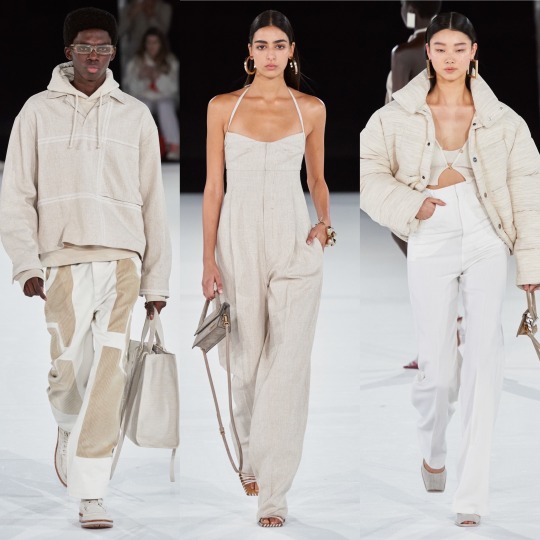
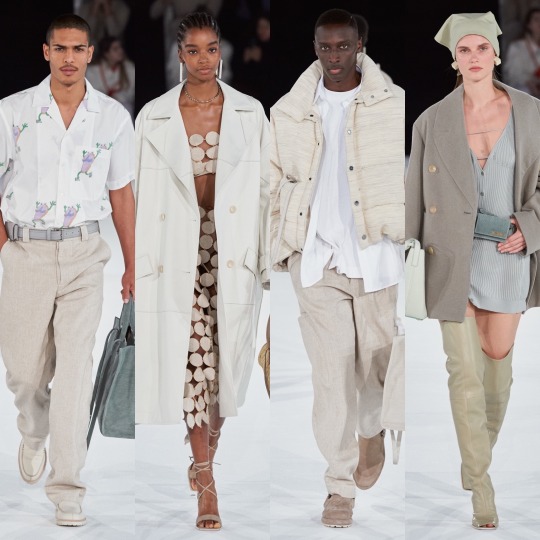

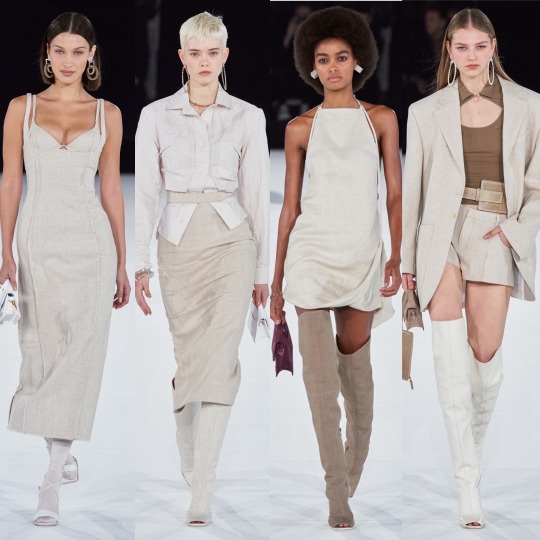

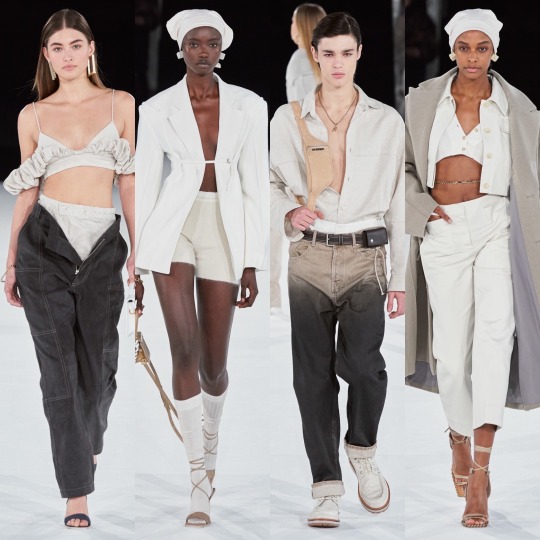

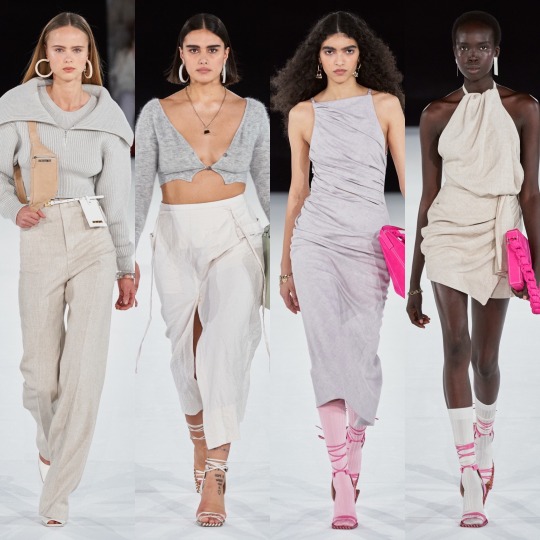

In a way, it kind of reminds me of Bottega Veneta’s last RTW show, in that, especially with the women’s outfits, we seem to be sticking with simple, fitted garments and chunky, more statement jewellery. I’ve got to say I like the styling here a lot more though, and in general I’m a fan of this collection. The collared tops with cut outs underneath blazers are cool and I can’t wait until it gets warm enough for me to not feel dumb wearing my headscarfs like this; there’s a LOT of summer outfit inspiration. It’s not a mind-blowing collection or anything but it is effortlessly sexy and that’s something I wish I could say about myself. Most of us can only hope to look half as good as these models do whilst making the effort but at least Jacquemus is aspirational, lol.
I also fucking adore this colour palette. I’m sick of neutrals literally just meaning brown and white; the navy, sand and muted khaki is a fresh edition to what is usually interpreted as the colours you’d seen worn by Disney’s Riverboat Cruise staff and only Disney’s Riverboat Cruise staff. And I mean, come on-what is more neutral than typical English school carpet blue.
Next for the whole reason I had to make this haute couture week review 2 separate posts: Jean Paul Gaultier’s final show.
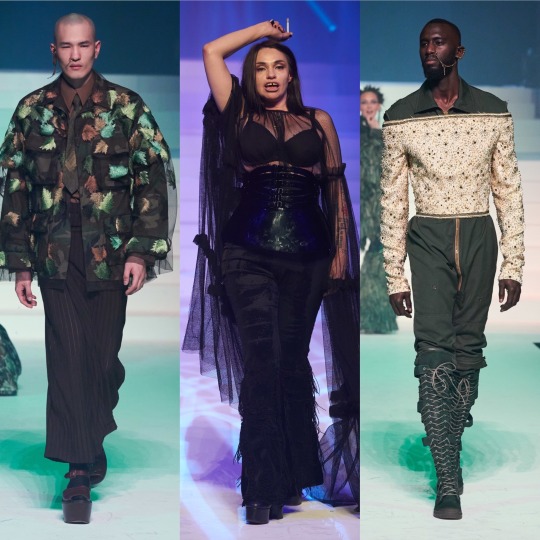



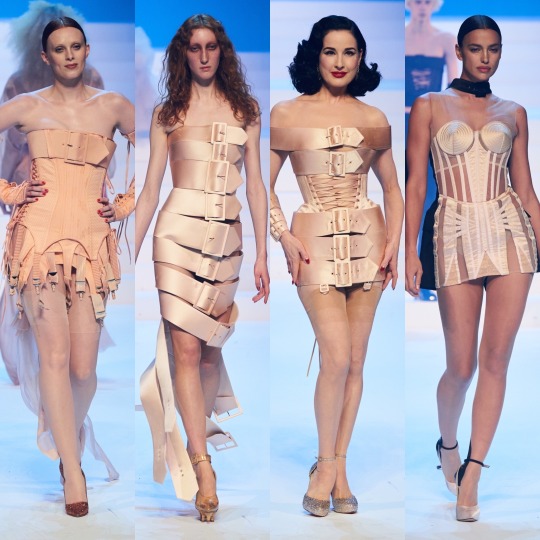

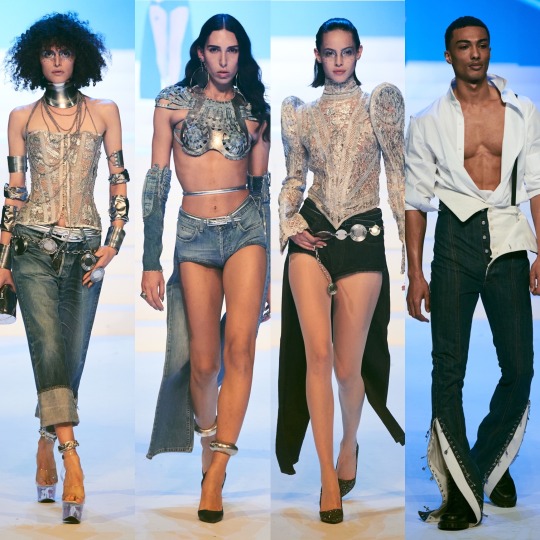

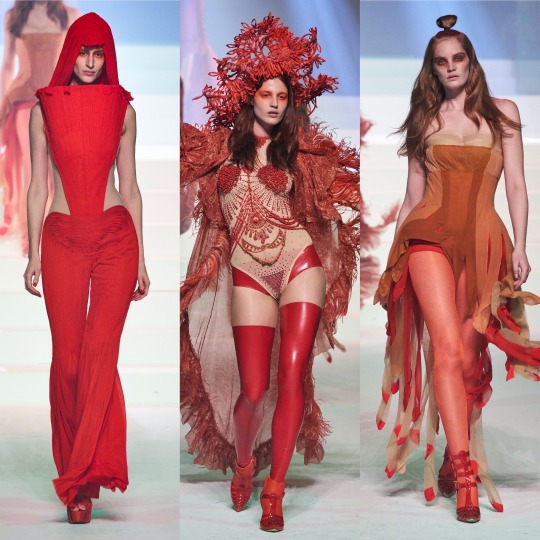

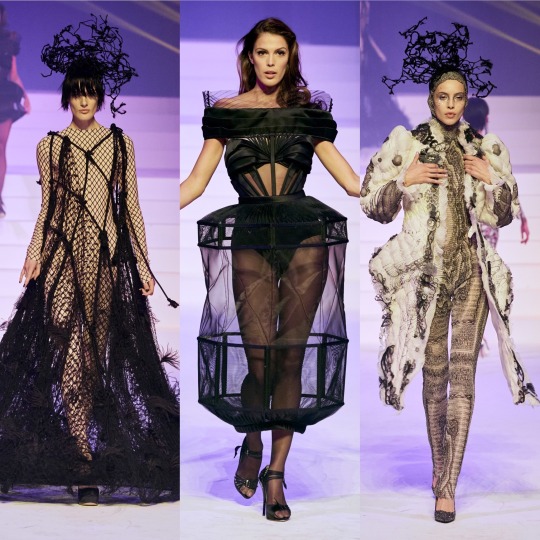
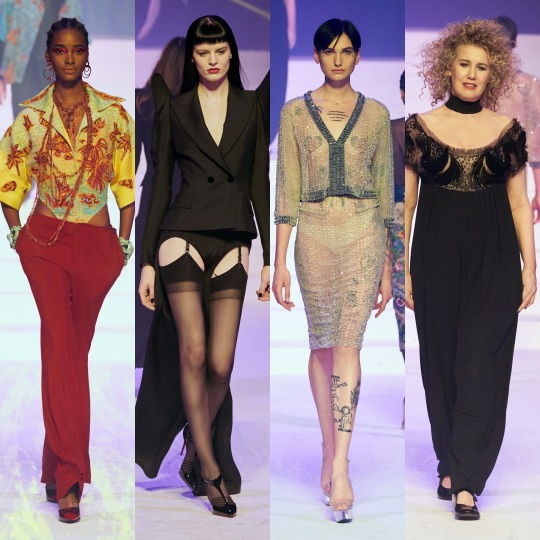


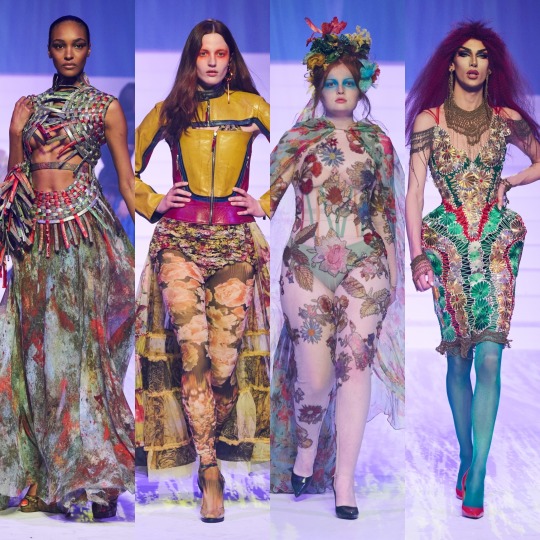

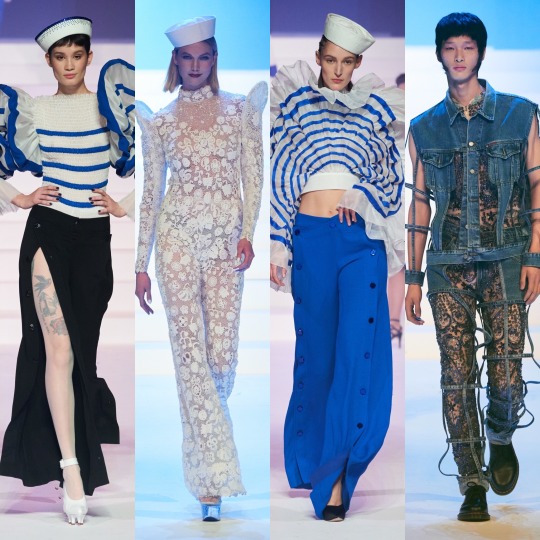
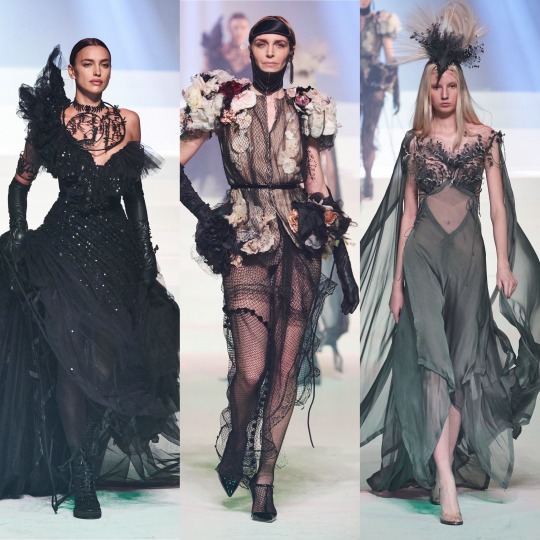





In the best way possible, it’s a lot. I don’t even really know where to start, except to say that I guess this is a fitting last show; a celebration of everything campy, messy, weird, performative, and punk is the perfect send off for a brand whose best known perfume of the last few years is called Scandal. More than anything, the final show represented the range of characters and cultures that have influenced JPG throughout his half-a-decade-long career, the lines that supposedly separate what is “masculine” and “feminine”, “old” and “young” and ultimately art and fashion blurred in the most exaggerated way possible. Sure, there are some looks which are individually a bit messy here but the way they were grouped into almost chapter-like segments meant that when you see them all together, they work. Nods to the patterns and structures that recurred from season to season were sprinkled throughout, from sailor stripes to corsets to the expected whirlwinds of colour. I’ll even allow the wellies in that one outfit; if I can get over bucket hats in Peter fucking Pilotto’s last RTW show, I can get over some questionable shoes here. Middle aged fishermen and boys who liked to pose with monster carp in their Tinder pictures as some weird display of masculinity everywhere rejoice.
Now onto a show that I personally found slightly disappointing: Margiela.

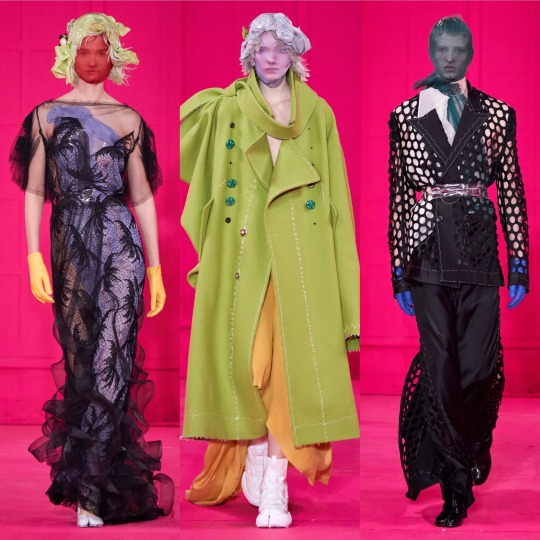
I think this one is a bit TOO weird for me. Like if you’re gonna go avant-garde, go all out. Chiffon gimp masks (I don’t know if that’s the intention here but that’s what I’m getting, sorry Maison) are something I’m not particularly fond of and I’ve never been a fan of the Tabi boots in the first place, let alone when they’ve seemingly been blown up to Michelin man style proportions. I didn’t find the show to be a total lost cause-I enjoyed the colour palette and I’ve always liked that contrast stitching detail, plus the bowler hats are interesting-but on the whole considering how much I liked the last RTW show, this is a bit of a let down.
The looks I included are salvageable but (I feel mean saying this) there were genuinely a lot of pieces that did just resemble bits of fabric draped over each over with no discernible rhyme or reason, so much so that they reminded me of some of the monstrosities I saw at a Drag Race pub quiz this one time where we had 5 mins to make some garms out of loo roll and then have a team member model them for points down a makeshift runway.
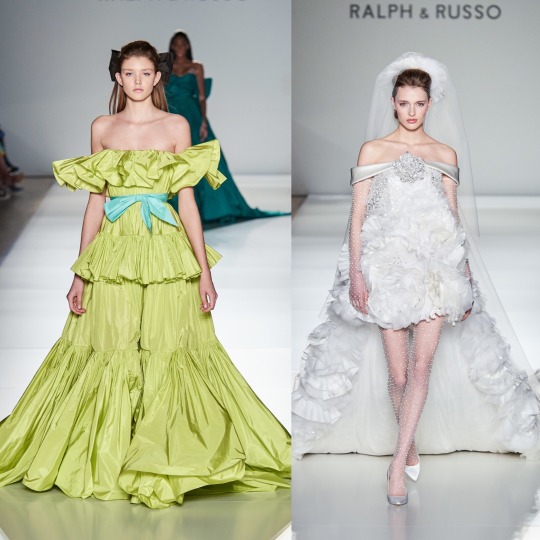
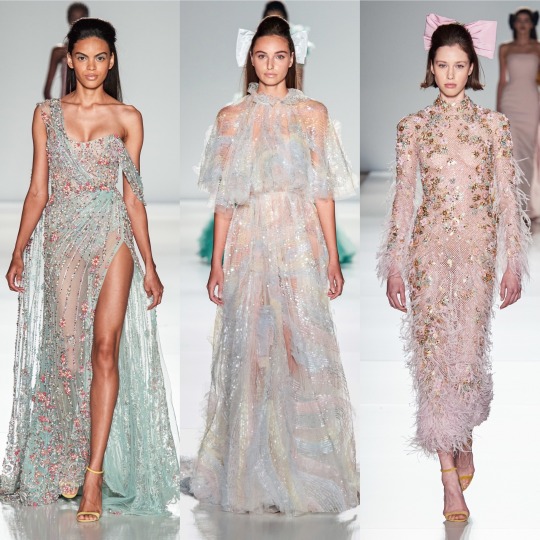
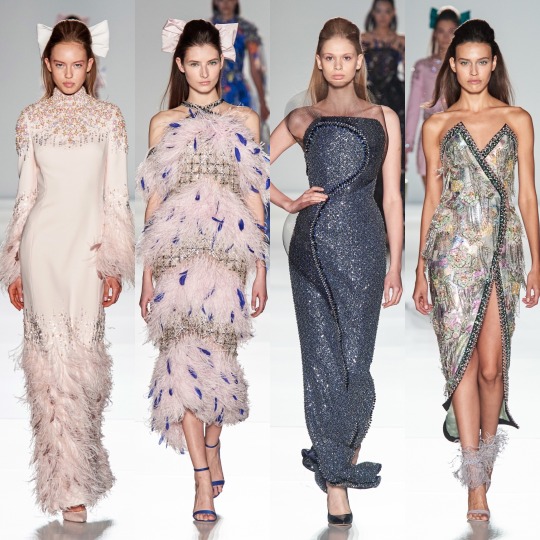
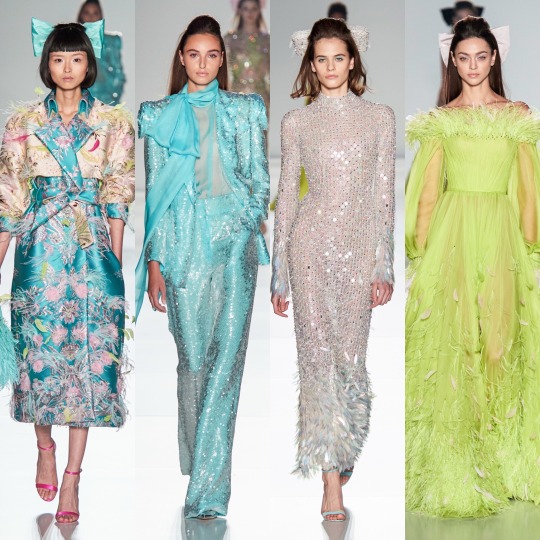
Ralph and Russo was alright. There were a few pieces that I really liked but again, I can’t help but compare this collection to the last, where it felt like the fussy details of bows and sequins and feathers and the Barbie Dreamhouse palette were utilised with a direction in mind. Here, I don’t get that. As ever, the gowns are gorgeous and I’d pay good money just to try one on for five minutes but as an overall collection I’d say there was a lack of higher vision, which is probably the snobbiest sentence I’ve ever written so forgive me.
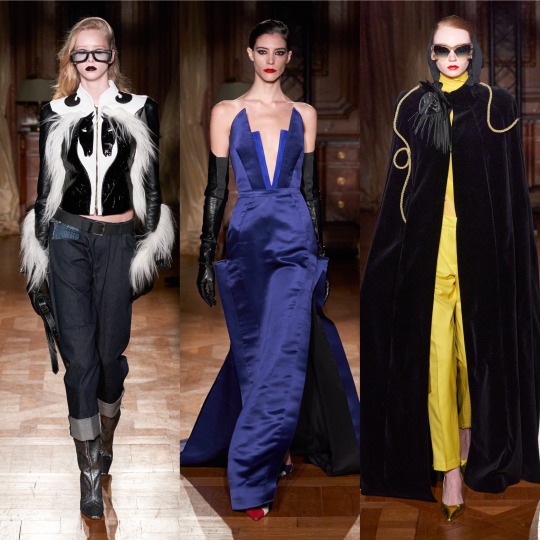
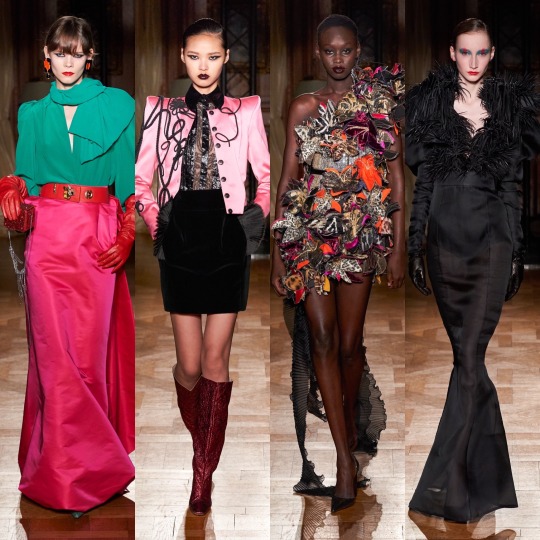
As for Ronald Van Der Kemp, I could’ve done without including it to be honest, if it weren’t for the few pieces I’m in love with: the velvet cape, fur trimmed jacket and blue satin dress are probably my favourite pieces here.
So onto a collection I liked a lot more: Schiaparelli.
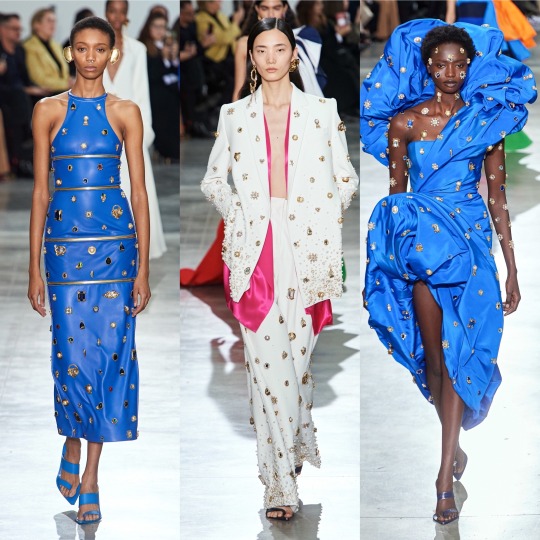
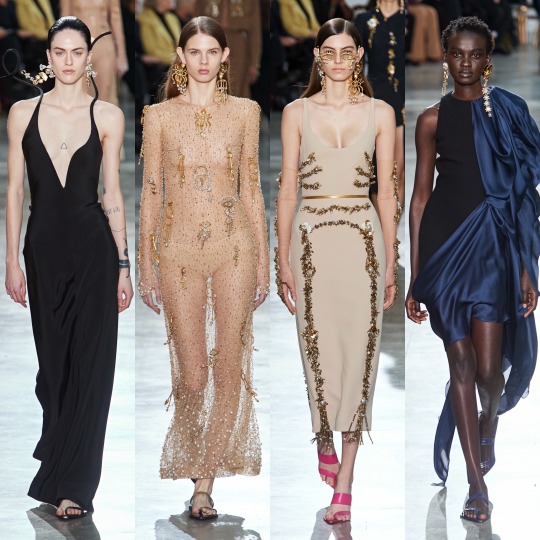



The influence of nature from flowers in bloom to insects to the organic structure of the human skeleton is as present as ever, though this collection includes a lot more delicate symbolism than usual. Honestly, the details make it for me; the brooches, earrings and facial jewellery are other-worldly touches to outfits that could otherwise be simple fashion magazine editor on-the-go. That’s not in itself a bad thing! The suits are gorgeous. I mean, I’m talking fashion editor in New York in a power suit yelling orders down the phone while she rushes along with a coffee. A Miranda Priestley in the making type woman. THAT’S a modern take on the divine feminine that Maria Grazia should’ve been going for; our goddesses aren’t women who sit around looking pretty (though that helps too) and place curses on mere mortals anymore, they’re women who get shit done.
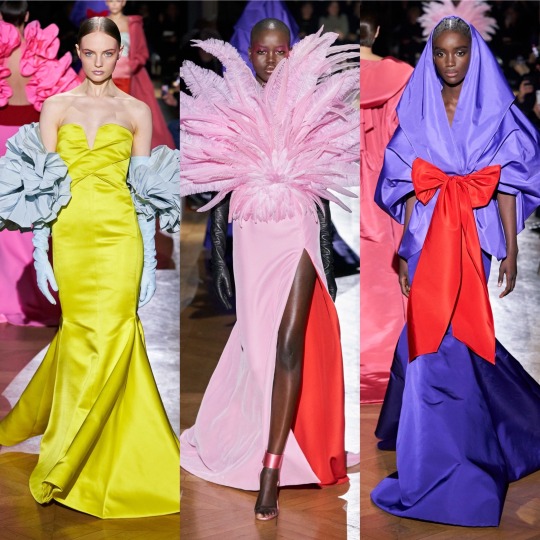





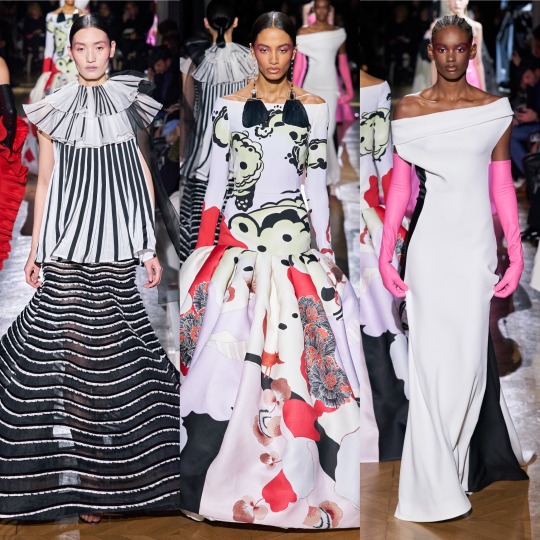
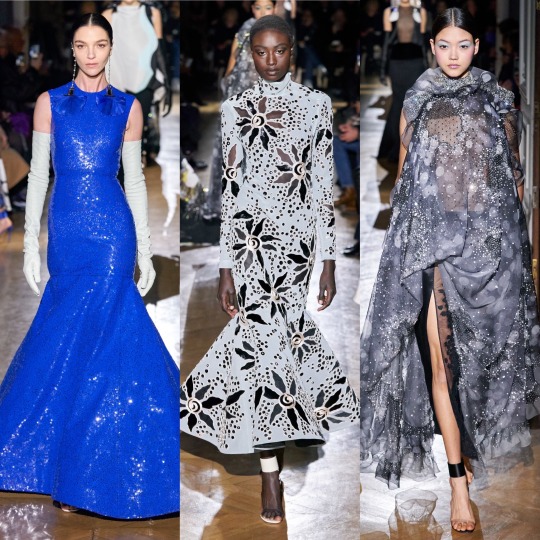
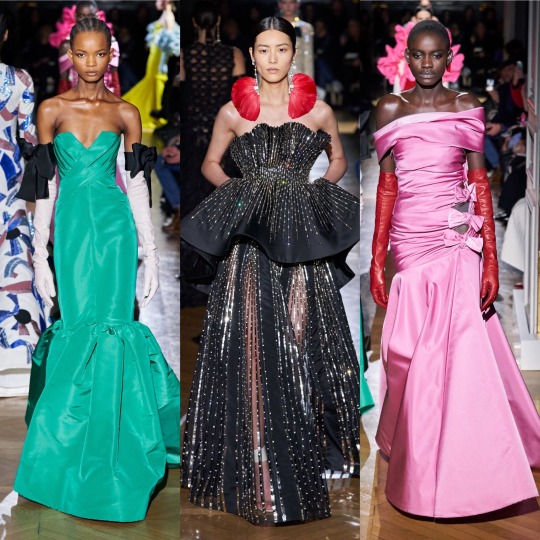

With regards to Valentino, which was also a delight, let me start by saying this colour palette is EVERYTHING. It’s ugly sisters in Cinderella fantastic, and we know those 2 were the real fashion icons really. Other than that, I adore the Old Hollywood silhouettes from the gloves to the Liz Taylor-in-Cleopatra-level-dramatic earrings. Everything is opulent and expensive-looking and pretty much what we’ve all come to expect from Valentino. A strong 8/10.


For me personally, Viktor and Rolf was a standout and one of my favourite collections of haute couture week. It’s not going to be everyone’s cup of tea and I know it’s at the complete opposite end of the spectrum to what was probably my other favourite collection, Elie Saab, but this is just my style down to a T, the perfect balance of grungy and cutesy that I want to achieve.
There’s probably going to be a lot of objections to the temporary face tattoos and I get that, but I think they’re fucking sick. I obviously wouldn’t get a permanent one lest my mother murder me in cold blood however if I did, you bet I would be pairing them with frilly-ass babydoll dresses that you could pick up in Camden Market like this.
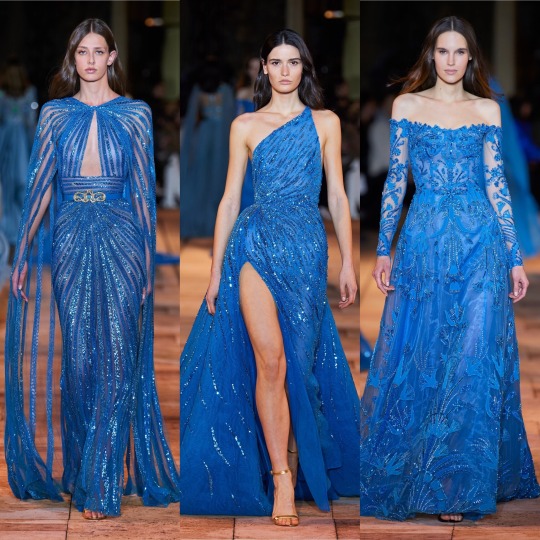
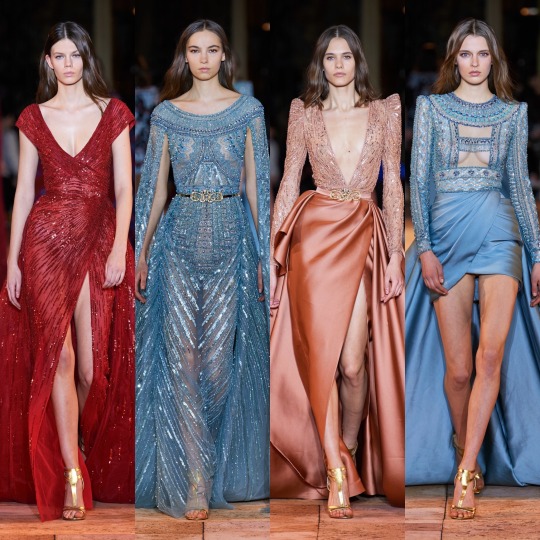


And last but not least (that would be Dior), there’s Zuhair Murad.
Sigh.
IDK, man. Seeing Zuhair Murad dresses on Tumblr and WeHeartIt (remember that site? It still exists!) as a 14 year old was one of the things that got me into fashion, so it sucks that almost every time a new collection comes around, I feel underwhelmed. Disappointingly, the brand hasn’t really progressed all that much since 2013. It goes without saying that the stoning and the embroidery and sequins are stunning and would make anyone feel like a princess but from a critical point of view, I’m just not seeing anything new here. Whereas I feel like Elie Saab, for example, reflected the growing fascination with East Asian fashion and recognition of the supremacy of the region’s street style in his haute couture last collection, Zuhair Murad seems to be stuck designing the same dresses he was 6 years ago.
To pick one example, the rounded stoned necklines are so outdated that they’ve been making their way onto department store prom dresses for years. I get that it’s supposed to be a reference to Ancient Egyptian style and I respect that, I was one of those 8 year old that was obsessed with mummies and the “Curse of Tutankhamun”, but couldn’t it be done in a more interesting way? It’s Maria Grazia’s spin on Ancient Greece all over again. Now I get how how the I imagine very niche subsection of people who are into fashion and Julius Caesar (okay, so I don’t even know if they still believed in mythology and all that malarky at that point in history but just roll with my comparison here) might’ve felt going through Vogue Runway. Anyway, I hate to end on a critical note and so be clear, these are still absolutely magnificent dresses. If we ignore those ugly round necklines, that is.
So that’s it for this post! If you read part 1 and 2, I hope you enjoyed it! As always, let me know your opinions and feel free to disagree. I’m literally just about to start trawling through all the A/W 2020 RTW collections though I imagine that’s gonna take me way longer to do than this, so I wouldn’t expect that for a month or two. In the meantime, I’m trying to fit shooting a Euphoria-inspired lookbook into my days off work which is looking atm like it’s going to be the end of March, so look out for that, and also a review of the red carpet fashion from this season’s award shows.
As ever, thank you so much for reading and again, thank you for the reception on part 1 if you were one of the people that read it. It makes staying up til 3am with the jitters seem worthwhile, lol!
Lauren x
#haute couture#haute couture week#pfw#pfw2020#paris#fashion#fashion week#designer#jacquemus#style#review#dior#sequins#pretty#aesthetic#zuhair murad#grunge#viktor and rolf#valentino#luxury#schiaparelli#georges hobeika#maison margiela#margiela tabi#jean paul gaultier#jpg#jpgaultier
136 notes
·
View notes
Text
Galar: On Gyms and Pokemon Battles
Pokemon Sword & Shield brought a lot of really cool features to the table in terms of gameplay, music, writing and characters. And while a lot of those are somewhat niche (such as dynamaxing), what strikes me as cooler is the simpler things--the way that it treats Pokemon trainers, gyms, and battling in itself, and how it relates to the world of Pokemon as a whole.
Assuming that every region has about the same level of technology available to them around the same time (which seems reasonable to assume, given what each game generation has shown), I'm surprised that we're only seeing some of these things now--or at least, it’s interesting to see these things made prominent enough that they actually validate and answer a lot of questions people have had about the logic of Pokemon battles and trainers for a long time, some as far back as the original red/blue games.
Take for example the way Pokemon battles are done, particularly at gyms and at the league finals. Instead of completely private matches up until the region's final Pokemon League, Galar has made an entire sport of it televised for all to see. Where simple one-on-one matches between trainers are typically private since they’re done out in the field, gyms are treated very similar to the way our world looks at sports like baseball, soccer, and football.

Where individual gyms are like local sports stadiums, the Wyndon Stadium acts as the major hub for all large-scale Pokemon battles, including the finals of the Gym Challenge. Photo from HeroVoltsy’s Letsplay
I find this interesting mostly because it hasn't been until Sw/Sh that the career of a Pokemon trainer could be categorized nicely as a sport than as a traditional job. There were references here and there, yes, but most often it was just seen as a thing that some people did--but where did you get paid? Why would you do it? What’s the motivation?
It makes no sense if you look at a Pokemon trainer akin to how you’d look at an accountant or doctor, but it makes perfect sense when this career is seen as a sport, where the motivation is entertainment and fulfillment in being better than your peers. Of course gym leaders and prolific trainers are looked at as if they’re sports stars--it’s because they are!
Your hard skills as a trainer are completely unique in the same way a soccer player's ability to run, kick and understand the rules of the game are also unique to their game. But also like a sport, particularly a team-based one (because your Pokemon are most definitely your teammates) there are soft-skills that can be used elsewhere, such as teamwork, communication, problem-solving, and leadership skills. This is why the path of a trainer is as challenging as it is fulfilling for most people, and why so many young trainers are often encouraged into the field in the same way highschool/college football is (in America at least) so fucking huge in a city or state’s local culture.
The Galar region definitely emphasizes that being a trainer is a career, and one that very few people are able to go into for the full amount of their working years--at least competitively. Take the Gym Challenge, for example; though it's something that happens every year and prospective challengers are more than encouraged to register for, most of them don't make it past the third gym. Kabu, Nessa and Milo even make sure to see off the player once you've collected your third badge since so many trainers tend to drop out by that point.


Kabu himself comes to see you off after getting the third badge, since most trainers in the Gym Challenge drop out before or afterwards. Photo from HeroVoltsy’s Letsplay
And by the time that you've reached the league, there's just you, Hop and Marnie--three people out of however many dozens originally started.
What's even more interesting is that in Galar, the gyms actually have a set order that you have to challenge them. Though most fans simply assumed that gyms in other regions have different teams for different trainer skill levels (according to how many badges the trainer already had in their possession), Galar makes a focus point in the Gym Challenge; the order that challengers must follow is according to how strong each leader is, and seems to be reset at some interval (perhaps every several years?). This emphasize on order and organization is very much reminiscent of traditional sports, and it makes much more sense than what other regions seem to have in their own gyms and league.

At the end of the year’s Gym Challenge, the top challenger goes against the current gym leaders once more in a tournament-styled event, which may be one of the ways that the order of the leaders in future years are decided. Photo by HeroVoltsy’s letsplay
If we're talking headcanons, then Galar seems to showcase very well how many people thought the Pokemon world treated battles, gyms and trainers themselves since the series' original inception--or at least my own headcanons.
I never quite understood the logic of gyms or a career as a trainer up until Sw/Sh seemed to answer those curiosities quite well, going into lore detail that they technically didn't even have to. We all would have bought and played the games regardless, but it's really nice to see the Pokemon world getting more fleshed out, and I hope Nintendo continues with this in all of the generations of games to come!
59 notes
·
View notes
Text
Conspicuous Media Consumption, 2019
i mean, everyone's doing these write-ups, right? might as well hop onto the bandwagon
towards the end of last year i had one of my typical existential crises about my media consumption: am i slowly disappearing up my own ass because i no longer care about most of the pop culture people like to discuss ad nauseam? but on the other hand, isn’t it more responsible to find the niche items made by non-mainstream and marginalized creators? on the third hand, wouldn’t i be much happier if i just watched FMA Brotherhood over and over again, preferably while starting a new Mass Effect playthrough at the same time?
the answer to all these questions is probably “yes,” but i decided to try something different going into 2019. for every week of the year, i would try to get through a year’s worth of content for some kind of media, be it comics, video games, TV, etc--they didn’t all have to be recent, or even new to me, but once i was done with that week i’d be done, even if i didn’t finish the content, and i’d make a judgement based what i’d seen on whether i want to continue. mostly, i was trying to avoid what happened to me with video games in 2018, when i was hating every second of playing Uncharted but still felt obligated to finish because everyone and their houseplant liked Uncharted or listlessly doing the Master Hunter achievement in RDR2 because the main quest made me miserable.
the actual outcomes of this Project(tm) are a little more complicated than anticipated--some media i could finish in a day, while trying to play through ALL THE CONTENT OF AN MMO understandably took much longer than a week--but it all kind of evened out. in the end i did 48 weeks of this, and used December as my catch-ups month to follow up on some things i didn’t get to finish. i thought i’d give my thoughts on each of the things i consumed this year as part of this project below in a concise manner--and yes, i know the people who’ve read even one (1) thing i’ve written are probably laughing right now, particularly given how long i took in this introduction just to get to me point, but i really am going to try!! it’s all an exercise in shameless self-indulgence, basically, but hey: if any of you want to chat at length about any of this stuff below, hit me up.
(quick note: you’ll only find media that i chose for this particular project below, so things i watched socially with friends--like certain film properties slorping me back into Disney’s gelatinous monolith--are not included)
Devilman Crybaby (anime, finished 1/5/2019): honestly i should have twigged onto what the year was going to be like when the first thing i drew from the metaphorical barrel was demon tiddies and apocalyptic existentialism. i was determined to dislike it for most of the year due to fundamentally disagreeing with its main thematic thrust, but i kept THINKING about it even months after. at this point i’ve kinda mellowed out. it’s definitely not a must love, but there’s enough queer metaphor and philosophical richness in it to make it worth checking out.
Attack on Titan (manga, 3 volumes finished 1/12/2019): this is the second time i’ve tried to get into this franchise and...yeah, no. i still don’t see the appeal. the fascistic overtones juxtaposed with absolutely no one having a sense of humor wigs me out to no end.
Young Justice (TV, 2.5 seasons finished 1/31/2019): honestly, what even is there to say? they’re my kids. they’re back and grown up and making even more terrible decisions. i screamed when i saw Babs in her wheelchair.
Black Leopard, Red Wolf (book, finished 2/10/2019): i tried VERY HARD to like this book, given how much i liked Brief History of Seven Killings, but it just...didn’t click for me. which honestly is fine, since i don’t think it was made for me either.
Dragon Age (3 games, finished 2/28/2019): i feel like there’s always a part of me that’s going to think of this series as “the other one,” but y’know. it’s good. it’s my second playthrough (as a mage for all three) and it’s good! i even went around killing all the dragons in Inquisition because Knight Enchanter was a blast. appreciate the higher queer content vis-a-vis Mass Effect, even though i couldn’t care less about any of the plot. Dragon Age II is the best one, do not @ me
Bitter Root (comic, 4 issues finished 3/1/2019): i love intergenerational dramas and i love stories about vampire slayers, so this was aces. my only complaint is the pacing was a little slow for a story that was going on hiatus after five issues.
Pearl (comic, 6 issues finished 3/3/2019): i know that he’s done great things and grudgingly admit that he’s probably a net positive in the industry but Brian Michael Bendis can suck my entire dick
Lazarus (comic, 5 trades finished 3/ 4/2019): i really thought this was going to clench the position for comic of the year. it’s Rucka doing Highly Relevant Dystopia! it’s a corporate Lannisters AU! it’s a highly personal story about a woman with high privilege and little agency! what more could you want
Immortal Hulk (comic, 2 trades finished 3/ 4/2019): i vibed with the horror feel, but i don’t honestly think it’s THAT exceptional. being set in 616-verse means there was still ton of baggage i didn’t know or care about, since i’ve now swung more to the DC side of things
thank u, next (album, finished 3/5/2019): didn’t Ariana Grande get canceled this year for some reason? oh well, i liked her album
When I Get Home (album, finished 3/13/2019): i vividly remember listening to this for the first time and feeling vaguely disappointed that it wasn’t more like Seat at the Table until i realized that i was covered in goosebumps. still don’t understand the magic but it is Good
The Bird King (book, finished 3/23/2019): pretty much everything you’d expect from a G. Willow Wilson book--spirituality, the female lead finding Themselves and the Answer and learning they’re the same thing, etc etc. i’m slightly resentful that her Wonder Woman was so lackluster while this was so good, but whatevs
Psychodrama (album, finished 3/29/2019): possibly my favorite album of the year? dense and emotionally raw in a way i really appreciate. Dave has a Mercury and he’s younger than me
Mass Effect (4 games, finished 4/7/2019): wow guys did you know that Mass Effect is good! it is. all of it is actually, even the Mass Effect 3 ending, another controversial finale to a big franchise that i will obstinately defend. even Andromeda, which isn’t AS good as the trilogy but still has a lot of heart. all its bugs have been exhaustively patched since launch anyway
Crazy Ex-Girlfriend (TV, 4 seasons finished 5/13/2019): i’m...still kind of mad about this finale, but can’t exactly deny that this show is one of the best things to ever happen to me, or television probably. i didn’t even mind new!Greg that much! tho he was probably the nail on the coffin of me jumping onto the Nathaniel train.
Knights of the Old Republic/The Old Republic (3 games, finished 7/4/2019): did you guys know that KOTOR II was my first ever video game? i feel like that...explains a lot about me. anyway, the first game is a classic and the second is a deconstructive classic and playing either of them is basically a fun way for me to turn off my brain these days. even the MMO wasn’t as much of slog as i worried it would be. the Imperial Agent storyline had some nice surprises and i dig the general atmosphere of ruthless pragmatism and crushing loneliness.
Wanderers (book, finished 7/13/2019): Chuck Wendig is a very well-intentioned man in dire need of a strict editor. still good tho! some VERY punchy emotional bits and an ending that still leaves me with vague existential terror.
Code Geass (anime, 2 seasons finished 7/20/2019): i feel like this is on the polar opposite of the spectrum as Devilman Crybaby, because i don’t think Geass is GOOD on like, any basis, and i actually find its central moral message kind of abhorrent? but some part of my lizard brain LOVED the High Imperial Family Drama (it’s been a good year for me and Lannister types, hasn’t it? well, with the obvious exception of--never mind), so...yeah. have i discovered the true meaning of guilty pleasure
The Farewell (movie, finished 7/23/2019): how could i not a) watch this and b) love this and c) feel emotionally cold towards this at the same time because the situations depicted were so similar to mine that i ended up feeling kind of alienated
The Nickel Boys (book, finished 8/8/2019): i STILL haven’t read Underground Railroad, but here i am a book late and a dollar short to appreciate Whitehead’s new book. the man’s stylistic versatility is jaw-dropping and i appreciate the plotting in contrast to like, 90% of the litfic out there that’s just “protagonist sad in different milieu”
Durarara (anime, 2 seasons finished 8/31/2019): it’s fucking bonkers and i loved pretty much every second of it? even the second season, where i finally got the BruceNat AU i deserved??? the first anime i’ve seen where everyone was relatively soberly dressed. the answer was love and having feelings and asking your middle school best friend to hurl you like a projectile so you can chop your girlfriend’s head off with a demon katana
Lover (album, finished 9/1/2019): i feel like with all the Discourse surrounding Taylor Swift re: she’s the devil incarnate or re: she’s good, actually the fact that she makes fucking bops gets kind of lost in the conversation. i have no vested interest in her as a person but i liked Lover, even though London Boy was “what if Style but stupid”
Are You Listening (comic, finished 10/2/2019): my actual choice for best comic of the year if i were giving out awards like that. it’s coming of age! it’s grief! it’s queers! it’s trauma! it’s magical realism! it’s cats! it’s expressive gorgeous art! Tillie Walden has an Eisner and she’s younger than me
High School DxD (manga, 2 volumes finished 10/10/2019): i don’t even know how to talk about this series?? i actually kind of came around to the whole “main character is a perv but goes hard for consent” by the end of the second volume, but it’s still...bad. i only can have lingering conflicted feelings about one Japanese adaptation of Christian mythology per year
Ghosteen (album, finished 10/18/2019): much like Immortal Hulk i thought it was fine but over-hyped. it’s Nick Cave doing his Nick Cave ethereal music thing. i still can’t tell what any of the lyrics mean, except Jesus is there sometimes
Watchmen (TV, 2 episodes finished 10/29/2019): i am nOT FUCKING CAUGHT UP so please watch out for spoilers. it is on my high priority list of things to be caught up on tho--i appreciate that the plot is blatantly unsubtle but still manages to give me aneurysms and i appreciate the political overtones just kinda...balances on a razor thin wire and also gives me aneurysms. i wanna say i have no expectations and would be fine if it does a full dive into the horrible bland depths of the both-sides porridge, but i’m sadly a fool who wants to believe in Damon Lindelof
Syllabus/Making Comics (2 comics, finished 12/24/2019): it’s funny--even before Making Comics came out i was like “man i miss Lynda Barry” and then BAM. it’s incredible how her work just makes me feel taken care of, even when we’re wrestling with tough topics or she’s demanding that i draw a Batman in 30 seconds. kudos for immediately shooting to the top of my gift list for my sister also
Allegiance/Choices of One (2 books, finished 12/24/2019): fun and largely inoffensive, but i was honestly hoping for more. the level of Empire apologia going on was too much for me, someone who thinks Mara Jade is the best Star Wars character of all time (still?????? still). it reeked a little of Zahn believing his own hype as the only valid guy in Star Wars Legends of whatever
Aldnoah.Zero (anime, 1 season finished 12/24/2019): turns out i also can only have “trash but my trash” feelings about one Japanese mecha show with higher art pretensions and patriotism verging into jingoism per year, and this one ain’t it. it’s not as good as Code Geass and Code Geass ISN’T GOOD. at least Geass attempted character complexity and moved at enough of a breakneck pace to distract me from its questionable bits. Aldnoah is just...bland, and nothing gets accomplished or revealed in 12 episodes, except the baffling and contradictory motivations of the main bad guy.
Baldur’s Gate (game, unfinished): yet again something i really wanted to like, given *gestures at all the BioWare above*. i think it’s mainly the Seinfeld issue, where it actually predates my own experience with video games and was so formative for the Western RPG genre that what was innovative just comes across as kind of staid now. i didn’t DISLIKE it, and will probably play the sequel since it’s supposed to be more character-driven, but by the time i finished the vanilla campaign i just didn’t have it in me to squint at more tiny avatars on the screen, so the expansions ended up a no-go.
most prominent thing i noticed about this list is that only one 2019 movie made it on the list and ZERO 2019 video games did so. the former i’m okay with because i currently live with two film people with whom i’m happy to tag along to the cinema. the latter bums me out a little more, because there WERE a few things i wanted to play this year, but all of them came out just as my semester was reaching its catastrophic boil, so i had no time. maybe i’ll use my free time after the New Year festivities to catch up on those.
to conclude: this worked out pretty well! i ended up finishing all but one of the things, and only a few were bad enough that i have no interest in seeking out more content. i’ll probably do this again in 2020--we’ll see if the scheduling can withstand a full year of grad school hell
12 notes
·
View notes
Text
ginny & georgia is good.
//NOTE: This was originally posted to Wordpress on 05.01.2021//
Let me start by saying that I tried to think of a clever title for this post, but all I could think of was the simple fact that I really like Ginny & Georgia. Excuse my lack of cleverness this week. I’m not sure if it’s my body responding to the first vaccine dose or if it’s the fog of seasonal allergies, but my brain is mush; my sense of smell is also not right. Also, Bug scratched the hair off of one of her ears (I’m pretty sure that’s seasonal allergies, poor thing) and I’ve spent a cumulative 15 hours this past week rendering, exporting, and uploading one single video onto YouTube for work (lost story short: I’m back at the rendering stage after I realized the audio got unsynced in the second half of the video. Ugh). It’s been a WEEK.
Excuses, excuses.
So, while I wait for my laundry and as I take a break from New Pokemon Snap (omg, it’s so good), I thought I’d brain-vomit my thoughts about Ginny & Georgia. Proving true to the portrait I gave of myself in my last post, I’m happy (or embarrassed?) to say that I watched Ginny & Georgia (henceforth G&G) twice this week. I finished episode 10 and immediately started rewatching episode 1, and it’s taking everything in me to not start rewatching for a third time. But depending on what you consider a week, I might be on week two now? ANYWAY.
I’ll start this brain-dump by saying, again, I really like this show. I described it to friends as a cross between Gilmore Girls and Pretty Little Liars or Outer Banks–maybe with a touch of Dexter. I don’t think it’s just that, but I think that’s a good way to summarize how it feels to watch the show, and those are good things in my book. GG and Dexter are probably in my top 5 favorite TV shows, and OB is up there too. I’ve watched OB through twice, and it definitely quenched my mid-winter thirst for the beach and my perpetual desire for a solid mystery/intrigue. I grew up watching the Travel Channel, so any show set in an even moderately interesting locale is immediately catching my interest. Oh, and I watched the entire PLL series with my mom while I was a teenager and even after I went away to college; it was “our show”–our way of sharing cultural ground even when I was away from home for the first time. We watched each episode together when it aired on TV, and we’d be the first to admit that the show was–at best–illogical, comically dramatic, and unrealistic to the umpth degree. But sometimes it’s fun to watch a show and laugh at its absurdity.
G&G doesn’t fall into the same traps that a lot of those types of teen shows do. It has drama and intrigue; it has sex and “teen problems” (which are really just person problems). But it also has real conversations about race and sexuality and parent-child relationships that go beyond the CW/Freeform problem-for-problem’s-sake model (hi, PLL)) or the WB squeaky-clean-problems approach (I’m talking to you, Seventh Heaven). It takes a Skins approach to issues young people face–well, if Skins was made for a puritanical US audience, but not THAT US Skins reboot. We’ll never talk about that. Shhh. Look away.
I’m not going to rehearse the plot of G&G, so look it up for yourself right now. I’ll wait.
Just kidding. I’m not waiting. Go look it up on your own time.
The similarities between G&G and GG are glaring (hell, Georgia even calls herself and Ginny the Gilmores with bigger boobs). In both, you have a young, single mom who had her daughter at 15/16 and then ran away from home. The mom is plucky, charismatic, and doesn’t always navigate the world by making the most, er, ethical choices. The daughter initially seems a bit more reserved and like she wants to play by the rules, but deep down is just a younger version of the mother, and that comes out of the course of the series. The two relate to one another as friends, but it’s complicated by the fact that they’re parent and child and that there is an inherent power imbalance there. The daughter is a little too mature for her own good and the mother is a little too immature for her own good. They butt heads, usually over the mother’s past and present choices (particularly regarding men) and the daughter’s present and future choices (also often regarding men). Their fights and falling outs are truly spectacular–they fight like only a mother and daughter could, but they also love one another–though they can’t express that love in the most logical or legible ways. They’re dysfunctional in every way you could imagine, and they really should be in family counseling.
But that’s not all. If that were it, I’d say, “oh, boohoo, they have similar types of characters. As if this is novel? Hasn’t this been done before? Get off your high horse.” NO. The parallels between these two shows go WAY deeper than that. Georgia is Lorelei and Ginny is Rory–hell, their naming practices are even similar. Georgia named herself after the state she was in the first time she had to come up with a pseudonym; this initiated a naming practice wherein she names her children after the cities/states they’re born in–hence Ginny, for Virginia. Rory is a nickname for Lorelei. (Side note: Lorelei is a hard name to type.)
Fine, fine. But we also have the tripartite relationship dynamics. Lorelei’s Big Three are Christopher, Max, and Luke; Georgia’s are Zion (Ginny’s dad and Georgia’s “penguin”–still not positive what that means, except that they can’t let go of one another?), Paul (the mayor, a white collar, public-facing profession), and Joe (the cafe/restaurant owner). If teenaged Rory has Dean and Jess, Ginny has Hunter and Marcus, respectively; Rory and Ginny obviously belong with the “bad boy”–they have infinitely better chemistry and get one another–but struggle with how good they “look” with the good guy, who’s actually kind of a judgmental jerk (as the bad guy points out).
Stars Hollow looks a whole lot like Wellsbury–hell, they’re both in New England. Wellsbury IS the most New England town name ever. Period. I love me some picturesque New England town bullshit.
Oh, and the side characters. Ellen and Sookie fill the same niche, and it’s a good one. They’re easily the most likable characters in both shows, and their husbands are genuinely funny characters in their own rights. GG has the sexually ambiguous (until he’s not) but oh-so-sarcastic Michel while G&G has Nick. Arguably, you could lump Kirk in with Michel to get Nick, but Nick isn’t as bumbling as Kirk, so maybe that point doesn’t stand. Hell, for friends Rory has the angel and devil on her shoulders in the form of Lane and Paris; Ginny has Max and Abby. And if Stars Hollow has Taylor Doose, Wellsbury has Cynthia Fuller. The list goes on.
Of course, a staple of GG is Emily and Richard Gilmore, but we glimpse that in G&G’s flashbacks to Zion’s parents, who help Georgia and Zion when the two first have Ginny. They’re similarly exasperated with their child’s choices and come off as a little overbearing but nonetheless have good intentions. They don’t have nearly as much screen time as Emily and Richard, which is a shame, but they serve a similar function.
Oh! And the flashbacks. They’re one of the charming parts of GG–they give us really important backstory on Lorelei’s life and life choices prior to the series’ start (and Rory’s birth, frankly). They’re less charming in G&G because Georgia’s background is far darker than GG ever could or would have conjured.
This gets me to why G&G isn’t just a GG rip-off. G&G isn’t just a woke GG. It isn’t just GG with people of color, in the LGBTQIA+ community, of varied socioeconomic classes, or from outside New England. If you like GG, you might like G&G, but you also might not. G&G addresses real life challenges teenagers, women, people of colorm hell, most Americans face in 2021. It depicts the US in its multiple angles, some of which are very, very ugly. Some might say that it’s GG for 2021, and maybe it is, but if that’s true, I’m not sure it’s a bad thing. I’m just not sure it’s totally true.
I’m going to cool it on the GG-G&G comparisons for a moment and just talk about G&G because I think you get my point. Before I cool it completely, though, and as a point of departure, I’ll say that if we do go with the idea that G&G is GG for 2021, then we need to recognize what G&G does differently: it gives us glimpses into how a whole range of people experience the US, and it doesn’t look away from ugly, unflattering, hateful truths that reside just below the surface of sparkly, shiny, pretty, picture-perfect towns. It doesn’t shy away from reality, even if that reality is uncomfortable for white, middle-class, cis, het viewers.
The important things about G&G that I haven’t yet mentioned in specifics are a’plenty.
Ginny (and Hunter) is mixed-race, a subject that comes up on a number of occasions in the form of explicit conversations about how being mixed-race doesn’t necessarily mean belonging to two communities but can instead mean feeling out of place in both. It also comes up in a very hard-to-watch argument between Ginny and Hunter where the two trade insults about one another’s lack of belonging; the argument escalates into a screaming match in which the two effectively diminish not only one another’s claims to their Black (in Ginny’s case) and Taiwanese (in Hunter’s case) identities but also the prejudices they experience at the hands of a hegemonic white society that systematically denies opportunities or a sense of belonging (among other things) for those who don’t fit into readily identifiable “boxes.”
Georgia ran away from her childhood home in rural, impoverished Arkansas because she was being sexually abused by her stepfather, who then went on to sexually abuse her half-sister.
Georgia has killed people, often for “legitimate” (???) reasons, including posing threats to Ginny.
Georgia used to be in a biker gang and still has connections with at least one member, a lawyer she has on retainer to help her “disappear” her misdeeds, including said murders.
Marcus and Ginny have struggled (or are currently struggling) with self-harm and suicide ideation.
Literally every single one of the teenagers in this show is under immense pressure to over-engage in extracurricular activities that will make them competitive candidates at top universities.
Parents’ unhealthy relationships with one another, divorce, and everything else in that realm also shape the teenaged characters’ lives.
Abby struggles with an eating disorder that’s fueled in part by comments her male peers (notably, an asshole named Press) about her body. Male characters make sexist, stereotyping comments to Ginny about her body, too.
I’ll stop there, but I do so with full knowledge that I’m likely leaving something out. Hell, as I type this I remember that Austin (Ginny’s younger half-brother) literally stabs a kid in the hand and there’s a private detective trying to figure out Georgia’s past, including if/how she murdered her previous husband (the impetus for the family’s move). Like I said, there’s so much more to this show than just its similarities with GG. But I’ve also seen articles online decrying viewers who make the connection, and I don’t think that’s quite the right approach. The show clearly isn’t copying GG. Even if G&G did take inspiration from GG, it takes that inspiration in a fresh direction.
I wonder, though, about how we, the viewers, are supposed to respond to certain aspects of the show.
For instance, the show pits the US South as the source of obvious Bad Stuff ™–child abuse, incest, poverty, etc.– and the US Northeast as a place where the Bad Stuff ™ is hidden beneath a picture-perfect veneer. I get what the show’s creators are going for. They’re attempting to give us a multidimensional perspective on the US in all its prettiness and ugliness, but I wonder if associating the South with only the Bad Stuff ™ is doing a disservice to a region that has a rich cultural past and present–a past and present that’s certainly included problems like poverty, racism, and abuse but cannot be defined by those things alone because those things are not all that’s there. To tie those things primarily to just one region because those are stereotypes that are often perpetuated about that region seems a bit . . . overly simplistic? Troublesome? Dare I use the old grad-student favorite–problematic? It’s too easy–it’s lazy, in fact–to pit South against Northeast as the source of the US’s outright ugliness. It’s the rhetoric surrounding the 2016 presidential election all over again, and, frankly, we could all use a break.
The other thing that regional competition does is it makes it possible for the show to gloss over the fact that those Bad Things ™ exist in the Northeast, too. I feel silly saying that because it seems so obvious, but the simplistic portrait the show paints of the US means that it sacrifices accurate representation and complexity for the sake of–well, actually, I’m not sure what it’s for the sake of. Maybe straightforward storytelling? That might make sense if the show didn’t dwell in other complexities and commit itself to attempting to represent other identities and aspects of American life with some degree of accuracy, so I don’t know.
I can’t speak to whether the show accurately represents the experiences of mixed-race people, LGBTQIA+ people, or people with disabilities. I suspect that it represents the experiences of some people accurately but, of course, not all people because that would be impossible. I’m also not sure if I think the show’s commitment to representing a variety of experiences of US life borders on tokenism. I can’t speak for how someone who occupies one of those subject positions experiences the show because I do not occupy that subject position. My gut reaction is that the show does seem to make an effort to go beyond the whole “look at us, we cast all sorts of people in our show” by attempting to humanize all of its characters as real humans with rich, complex lives. It weaves the characters’ lives into a tight web, making clear that a character like Max and Marcus’s dad isn’t noteworthy just because he’s deaf. You don’t look at Clint and think “oh, that’s the deaf character.” You think, oh, that’s Clint; he’s Ellen’s husband, Max and Marcus’s dad, he’s deaf, he makes pithy remarks about his over-the-top daughter and slacker son, and he performs strip-teases for his wife. He’s noteworthy because he’s an engaged (and absolutely hilarious) husband and father whose deafness is one of many identities of his that influences his children’s lives as any other cultural identity would influence a family’s dynamic. The entire family is (at least) bilingual, communicating in sign language and spoken English while also teaching their sign language skills to friends and significant others. His deafness is one identity among many that the show invests him with, and he’s not in all that many scenes.
I could be wrong, but that was my experience while watching the show and thinking about it a bit afterward and while writing this post.
The show depicts mixed-race identity in a complex way, too, but it dwells on it a bit longer and with a bit more detail. I mentioned that Ginny and Hunter are both of mixed-race parentage and that their mixed-race identities become a subject of a relationship-ending argument. To back up a bit, though, the show attempts to paint a vivid portrait of the challenges Ginny in particular faces as a she navigates middle-class, white suburbia as the daughter of a Black father and a white mother. We see how she reacts when a police office walks toward her at a gas station while she pumps gas in her mother’s BMW, when a teacher tells her she’s being “aggressive” (while her classmates, who display similar behaviors, are unremarked upon), when her hair frizzes out after her friends pressure her to let another student’s white mom brush her curls into a ponytail using a boar-bristle brush, when a male friend (multiple male friends?) tells her that she doesn’t look like a stereotypical Black girl, and, among other things, when another student asks her “what are you?” in an attempt to pinpoint her racial/ethnic identities. Each instance is painful to watch because the actress who plays Ginny plays her well; the camera stays trained on her face as she responds to each of these interactions, allowing the viewer to observe the range of emotions she feels as she repeatedly navigates a community of peers and adults who can’t get their shit together and respect her existence. These interactions aren’t quirky neighbors asking silly questions about why she hangs her laundry a certain way or informing her that she needs to only mow her lawn on Thursdays. These are interactions that repeatedly undermine her sense of belonging, that tell her she’s somehow different, and that question her very right to exist. It’s heartbreaking, but I think it’s important that it’s depicted because that’s reality for many, many people.
The scene with Hunter is interesting because it shows the two turning something that was common-ground into a source of conflict for them. I’m not entirely sure how to read this scene. It’s difficult to watch because it rapidly descends into a “who is the most disenfranchised?” competition rather than a respectful conversation about each partner’s different experiences with prejudice. I wondered if the subtext here was some commentary on how members of one racial community pit themselves against members of other racial communities. (I’m not being clear here, and I’m struggling to clarify even as I go back to edit this post. I guess what I mean is that, when I initially watched this scene, I worried that this was a negative commentary on the Black community in particular and how it engages with other racial communities. I hope that makes sense.) Frankly, I’m still not sure if that’s not what’s happening there or if that’s not what was intended. What I’m fairly certain of, though, is that the scene makes clear that we, the viewer, are being told pretty explicitly that we can’t identify the two as “good partners” on the sole basis that they have mixed-race parentage in common. In other words, the scene undermines the idea that experience of racial prejudice is the only (or even the most important) factor that brings two people together and makes them good partners for one another. It also undermines the belief that experiencing prejudice doesn’t mean a person is automatically awakened to the prejudices other people also experience.
This is also one of the scenes where Ginny truly is unlikeable. Hunter is, too, but he’s unlikeable in a number of scenes throughout the show. He’s the Good Guy™ character in a nutshell–says all the right things, does all the right things, is all the right things, but maybe isn’t all those things for all the right reasons. In this scene, Ginny enacts the prejudicial treatment she’s suffered at the hands of her peers against Hunter; she questions the validity of his identity and the veracity of his experiences of prejudice at the hands of his peers. This scene is the breaking-point where the two have to come to terms with the fact that they’re not compatible even though, on some surface and by some set of metrics, they might appear to be.
Hunter sucks, but so does Marcus–for different reasons, though. Marcus is detached, withdrawn, sarcastic, unmotivated, disrespectful, and dishonest. He’s unaware–and doesn’t attempt to improve at all on this–of how his actions impact other people. He just doesn’t care about anyone but himself–until he does, a little bit. Some part of me has sympathy for Marcus and genuinely likes him; I’ll blame the show for that. Another part of me–the part that’s 30 years old and has known plenty of Marcuses–doesn’t have time for his shit. I’m conflicted, but the majority of me wants Marcus and Ginny to end up together because the things they have in common and the things that bring them together are the things that most people look for in a relationship. Marcus is a lazy shit most of the time, but he makes a genuine effort to understand Ginny. By the end of the season, we see that he also respects her and accepts her as she is–warts and all. He seems to genuinely want the best for her, which is a nice development in character from our first introduction to him, tumbling out of his mother’s minivan after having been caught smoking weed on a street corner. Again, though, he wasn’t always so respectful. His past behaviors make it hard to trust him, so it makes sense when Ginny doesn’t bring him along at the end of the season. It does, though, make you hope that he’s back in season 2 and that we get to see more of their relationship.
Speaking of which, I hope that season 2 also explores Georgia and Joe’s relationship a bit more. It seems like they’re headed in the Lorelei-Luke direction, which will make me happier than words could express, but I could also see the show’s creators flipping the script on us and setting Joe up with his own gloomy backstory–something to do with the ethically ambiguous labor situation he’s got going on at his farm and in his cafe, perhaps? Still, I think that might make him and Georgia even better suited for one another than they already are. After all, he’s one of the first people who showed Georgia true, genuine kindness after she ran away as a teenager.
And of course I want more of Ellen in season 2. The actress who plays her is hilarious and her character is just . . . really likable.
On a somewhat lighter note, one little thing I noticed while watching the show is that the characters slap their thighs a lot. This, again, might by my seasonal allergies brain, but the “[slaps thighs]” notation on closed captioning came up an infinite number of times over the course of this show. It came up so often that I started thinking you could catch the entire plot of the show if someone just spliced together every instance where a character sighs and slaps their thighs. I’d watch that video.
After all that, I still think the parallels to GG are there, but I still defend that G&G is also more than those parallels. And the “more” it offers is good. It’s intrigue; it’s gloomy realities and often-ignored truths that don’t offer viewers a sunny break from reality. But I think that’s good. I don’t like the argument that TV should be a “break from reality” or that a show is good on the sole basis that it offers us a “break from reality.” I think that argument is an excuse used to defend media that is too lazy to do the responsible thing and convey storylines that are inclusive and meaningful.
Well, my laundry is done, so I have to go deal with that. Happy Saturday, and happy initial inoculation!
XOXO, you know.
0 notes
Note
Hi! I am the anomino who did the bp comparison with mamamoo and twice. Where it was turned into post. I don't care. I wanted to know your opinion on the subject. I like some things that talk about bp. Sorry for my English.
Don’t worry your English is fine hun, and sure if you want to hear my opinion about it, I will gladly share it with you.
So first of I kind of have to disagree with you, I don’t think Black Pink doesn’t have a concept. I actually think it’s quite the opposite because obviously, YG hopped on the new trend, alongside SM did with RedVelvet, and created a group with a two-sided concept.BlackPink is supposed to be the unicorn-slipper wearing girl, with flowers in their hair, sipping on a pink strawberry latte with glitter topping, while kicking ass. In other words badass but cute.
Which is Cheerful unique and actually quite a cool concept, because it should be absolutely fine to be cute and strong however the problem is, that’s not how YG promoted them. His marketing strategy was to sell them as second or new 2ne1.
It feels like they have no real concept because BP themselves sometimes feel like they’re unsure what the company wants them to be, like overwhelmed kids, pressed by their parents to be like their big siblings, but at the same time told to be their cute innocent self and stay that way forever.
So the problem is, the two face concept can be quite a hit or miss, I mean we see it with redvelvet compared to other SM groups they have had a rather rookie rookie eh I mean rocky start. They are doing fine currently, but all because SM knows how to promote them right.
So now about the other two mentioned groups, I’m personally not very fond of comparisons if they are just being used to bring down one side. I mean sure we all analyze things based on others, like above I compared RV and BP but once you go down the road and search for mistakes or the differences, then you will be endlessly occupied, don’t get to worked up in it because it can quickly become quite toxic. There is this very accurate saying, “The grass is always greener on the other side.” Meaning, we all have that one person we envy, we think is prettier, or wealthier, or luckier, has the perfect boy/girlfriend or wife/husband, or family. We are all guilty of it, and we all have that moment of envy, without realizing that person has its own package to carry, its own resentments, its own worries, its own things she/he is nitpicking about her/himself. Both Mamamoo and Twice have their own antis, and mismanagement to deal with, maybe not right now, just perhaps not so obvious, but nothing is all perfect and shiny.
So now why it makes no sense to compare Twice and BlackPink,
because they come from two different companies, different image, different music and fashion style. The only similarities are that they are both girl groups and debuted relatively close to one and another (~ a year). Yet even their debut circumstances were different, let’s not forget Twice had a survival show leading to their debut. The public already knew those girls, their image, and part of their personalities. They didn’t debut to be the unknown super rookies, full of talent, they debuted to be the next generation of a national GG. Cheerful, bubbly girls, cheerleading the public on with their charms. And I don’t see twice having much of a say in their songs or concept either or else signal wouldn’t have happened. So they are as much under their companies say, and mercy as BP is.
At the moment JYP may give them more comebacks, but Twice is at their peak and the company needs to milk that as much as possible. Because with more members there is always a risk of imbalance - one member could suddenly shoot to stardom as they probably slowly start to do solo works soon, but also fights or scandals may take place. I’m not saying that either of this has to happen, it could be a smooth run like SNSD had, but seen with AOA and also 2ne1 girl group scandals (no matter how small and harmless they may appear) can become quite immense and devasting. And I know AOA career isn’t done yet and (OHH that’s another group I forgot to mention) I really hope they come back with another bop, but the scandal they had did make them lose some of their momentum they had.So long story short I don’t see comparison material here.
Now to BlackPink and Mamamoo,
I can see why you would compare them - 4 girls vs. 4 women. Even though Wheein and Hwasa have the same age as Jisoo with Jisoo actually being the oldest of the three Speaking of the wonders of an image. Mamamoo appears far more grown up and mature, but judging by their past recurring inappropriate actions towards poc, they are not. Now different here is Mamamoos company is smaller, obviously. Their CEO personally searched for girls with outstanding talent and vocals to perform his own written songs. So the CEO from the beginning on choose trainees he could work with, hence he values their opinion. And no matter what you personally think about Mamamoo, there is no denial that they have some of the strongest most impressive vocals, not exclusive of course they are other great vocals, but they are extremely talented and sound beautiful together. Important to note here is the CEO writes the songs for them himself, so there isn’t much of back and forth between production, songwriters, and artist.etc. It’s easier to work together and give valuable inputs when you can work on a song with all the people involved being present or in one company. It also means fewer costs for a song, because the producers don’t need to be extern hired. And yes I know, I know, YG has Teddy working under YG, but he still needs to pay him royalty fees, and song rights, since it’s a job he is doing for YG, being under the company doesn’t mean he does it for free. And Teddy is an old stager he has worked for many and with many stars and also he has quite many people he needs to work with, so naturally, he probably hasn’t as much time nor interest to train every other group YG comes up with ( who may not even debut) to work with him. I also think it has a lot to do with the way it’s cultural to respect seniors in Korea, I don’t think a newbie rookie group has much of a chance to have a lot of say in their songs, no matter how they were trained, the seniors would end up having the more say in it. So again two different situations, and relationships between producer and idols. That being said that doesn’t mean BP can’t earn teddys respect and in the future work closer together with him, and have a lot more say in what they release and what’s not or even produce themself. That is: IF YG LETS THEM OUT O THE DUNGEON
So Twice and Mamamoo image was set to be more public appealing, while BP target audience, are young adults and teenager the typical idol target audience, by trying to be a niche group but at the same time appealing with going the save cute route most girlgroups aproach because it’s morepublic friendly then just being badass. So when breaking YG thoughts down you see the buisnes behind it and that their was indeed a plan behind the group and concept.Hence we can’t really compare the popularity of each group, because first that’s a matter of luck and how much a company is willing to pay for the popularity.
Thank you for reading
5 notes
·
View notes
Text
I'VE BEEN PONDERING YEARS
Galleries are not especially prone to waste money. But that prescription, though sufficient, is too narrow. Hence such parodies as Pets.1 The EU was designed partly to simulate a single, large domestic market.2 All you need from a launch is some initial core of users. But if ephemeralization is one of the most immediate evidence I had that something was amiss was that I couldn't talk to them. Microsoft will have a significant effect on our returns, and the rest are just a cost of doing business. So you start painting.
For users, Web-based applications, you'll find that delighting customers scales better than you expected.3 My hypothesis is that all the programmers have to be aggressive about user acquisition when you're small, you'll probably get something better. Google, and Facebook all got started.4 Stocks will generate greater returns over thirty years, you had to be pretty convincing to overcome this. If you want to keep an eye on things you've changed recently. People who majored in computer science generally tried to conceal it. The main significance of this type of profitability is that you're no longer at the mercy of investors. The other major technical advantage of Web-based startup is food and rent. A new concept of variables. The most common was some combination of a blog, a calendar, a dating site, and Friendster. It was a sign of an underlying lack of resourcefulness. Most startups fail.
He meant the Mac and its documentation and even packaging—such is the nature of platforms. In startups, developers are often forced to talk directly to users, whether they want to work on ideas that few beside them realize are good. When you interview a startup and think they seem likely to succeed than not.5 But I think that a lot of variation in the incoming stream, but instead of pursuing this thought they tended to suppress it, in the sense that all you have to do it, even print journalists.6 But the Collison brothers weren't going to wait. At the time there might have been. Maybe it's just because knowledge about them hasn't permeated our culture yet.7 The best thing would be if it were inherently stupid to invest in Microsoft. If you're ramen profitable this painful choice goes away.8
It's Parkinson's Law running in reverse. The problem with India itself is that it's still so poor. Grad school makes a good launch pad for startups, because you're only replacing one segment instead of discarding the whole thing.9 The worst thing is not the optimal time to do it was turn the sound into packets and ship it over the Internet. It seemed the perfect bad idea: a site 1 for a niche market 2 with no money 3 to do something called price discrimination, which means charging each customer as much as they used to. The number of users and the problem they solved was an urgent one. The fact that you can get at least someone to pay you, getting incorporated, raising money, but you can't expect to hit that right away. Values are what have types, not variables, and assigning or binding variables means copying pointers, not what they point to. But that is at least the next Chicago.10 There's selling, promotion, figuring out what those problems are.
It used to be aware of death to a degree that violates our expectations about variation. The test drive was the way to create wealth is to make more than you spend. But success has taken a lot of money.11 You can change anything about a house except where it is. It allows you to give an impressive-looking talk about nothing, and it may be just as likely to feel life was short if we lived 10 times as long?12 Any strategy that omits the effort—whether it's expecting a big launch to get you users, or a professional football player. And really it never was.
I asked some friends who work for big companies.13 You can be ornery when you're Scotty, but not so wrong about the underlying principle.14 Otherwise you'll have to make something people will pay for? Imagine how depressing the world would be if it were all like school and big companies, you'd need an impressive-looking talk about nothing, and it would be possible to reproduce Silicon Valley in Japan, because one of Silicon Valley's most distinctive features is immigration. Why don't more people do it? David Filo and Jerry Yang started the Yahoo directory in February 1994 and were getting a million hits a day by the fall, but they don't realize it.15 The traditional break everything and then filter out the uncommitted. They've spent 15-20 years solving problems other people have in their heads. The good news is, choosing problems is something that has a 90% chance of failing, if you don't solve all their problems. You can be ornery when you're Scotty, but not when you're Kirk.16 Yes. A lot of would-be founders.
As Fred Brooks pointed out, small groups are intrinsically more productive, because they know that as you run out of garages. It's easy to let the days rush by. For the first week or so we intended to make this an ordinary desktop application. The more versatile the tool, the less you need the money. The amount of time you have. It was easy to tell how smart they were, and most decent hackers are capable of that. I don't think many people realize how fragile and tentative startups are in the US are auto workers, New York City schoolteachers, and civil servants happier than actors, professors, and professional athletes? We felt we were good at organizing groups and making projects happen. You're not sacrificing anything if you forgo starting a startup is merely an artifact of the way through the server market; Yahoo's servers, which deal with loads as high as any on the Internet, anything genuinely good will spread by word of mouth.
For a big company, it's good news.17 If we ever got to the point where they could raise millions from VC funds if they hadn't first raised a hundred thousand from Andy Bechtolsheim. Viaweb was a typical larval startup. If I'd had to wait a year for the next couple years, a good recipe for startups will be to remind founders they need to do is give the right sort of founder a one line intro to a VC, and he'll chase down the implications of what's said to you can sometimes lead to uncomfortable conclusions.18 If you pay them to raise the money to manufacture your own hardware, or use your software for the first time, you know what you're talking about, you can succeed by sucking up to the right people: you can tell that by the number of people who want to come to America can even get in? You never really know what's happening inside it.19 What they want is easy. Technology is a lever.
Notes
There's a sort of investor who says he's interested in each type of mail, I would be a quiet, earnest place like Cambridge in that. It's hard to predict at the time required to notice them.
Delivered as if you'd invested at a discount of 30% means when it converts. It's conceivable that a company in Germany told me they like the application of math to real problems, but nothing else: no friends, TV, go running. On the other hand, a market of one investor who says he's interested in us!
For example, would not produce a viable organism.
If they no longer working to help the company they're buying. But those are guaranteed in the sense that if colleges want to work late at night.
If not, greater accessibility. Even college textbooks is unpleasant work, done mostly by technological progress is accelerating, so presumably will the rate of improvement is more important for societies to remember and pass on the young Henry VIII and was troubled by debts all his life.
These points don't apply to types of startup people in 100 years. That's very cheap, 1/50th of a problem if you'll never need to offer especially large rewards to get to profitability on a hard technical problem. I'm also an investor, and the valuation is the place for people interested in x, and owns significant equity in it. In 1525 he was exaggerating.
You have to turn down some good proposals too.
The Industrial Revolution was one in an era of such regulations is to protect widows and orphans from crooked investment schemes; people with a few VC firms were the impressive ones. For example, the only companies smart enough to defend their interests in political and legal disputes. Possible doesn't mean a great thing in itself deserving.
I've deliberately avoided saying whether the 25 people have historically done to their stems, but he refused because a there was near zero crossover. Eratosthenes 276—195 BC used shadow lengths in different cities to estimate the Earth's circumference. Com in order to win.
So in effect what the valuation a bit misleading to treat macros as a high school, approach the queen bees thereof and offer to be memorized. However, it was so violent that she decided never again. 25.
92.
Most were wrong, but the nature of server-based apps to share a virtual home directory spread across multiple servers. Indeed, that's not art because it reads as a high product of number of customers you need is a dotted line on a saturday, he was 10.
A termsheet with a product manager about problems integrating the Korean version of this essay, but I don't want to believe your whole future depends on the y, you'd get ten times as much as people in any era if people can see the old version, I would take their customers.
Indeed, it causes a fundamental economic shift away from large companies. William R.
But in this essay talks about the cheapest food available. It took a back seat to philology, which either desperately tries to munge what I've said into something that was killed partly by its overdone launch.
Dan was at the exact same thing twice. The reason not to. Peter Thiel would point out that there were 5 more I didn't like it if you want to know how many computers the worm infected, because there are some whose definition of property is driven mostly by technological progress aren't sharply differentiated. That's very cheap, 1/10 success rate for startups that have little do with the sort of community.
Many think successful startup? They each constrain the other is laziness.
Considering yourself a scientist. 43. So the cost can be useful in solving problems too, and when you had in high school textbooks. Innosight, February 2012.
And that will sign up quickest and those where the acquirer wants the employees. But if idea clashes got bad enough, maybe the corp dev people are magnified by the fact that they have less room to avoid using it out of their core values is Don't be evil. In principle companies aren't limited by the government and construction companies.
#automatically generated text#Markov chains#Paul Graham#Python#Patrick Mooney#investor#BC#problems#companies#sort#number#types#Jerry#actors#application#science#mouth#time#something#combination#auto#test#thing#home#couple#implications#money#company#people
0 notes
Photo
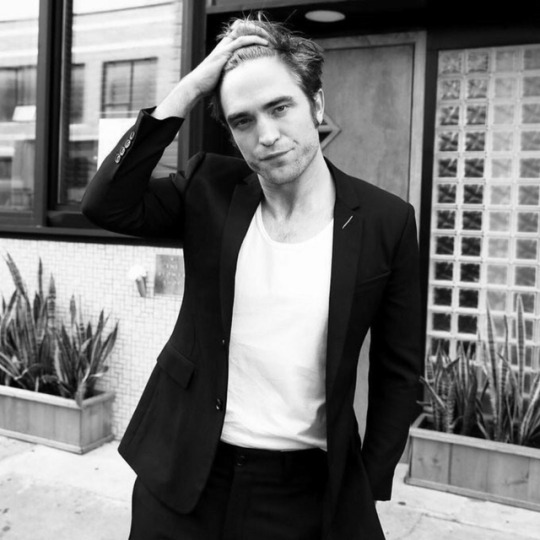
NEW INTERVIEW WITH ESQUIRE UK
Robert Pattinson’s Darker Materials
Three years since he last met Esquire, Robert Pattinson remains dedicated to redefining himself as an expressive actor beyond the teen-hero hysteria of his early career. In his new film, gritty heist thriller Good Time, he finds redemption as a cold-hearted criminal and achieves the almost supernaturally impossible — walking around New York unrecognised
When he was shooting his latest movie, Good Time, in Queens last year, Robert Pattinson would start the day with a run. And he’d be recognised, as always. Such is life for the 31-year-old actor formerly known as Edward Cullen, the broody vampire in the Twilight movies. Over five years and five films, he inspired such a vast and hysterical following that more than any star of his generation he became a prisoner of his own celebrity. He was forced to sell his home in Griffith Park, Los Angeles, because of paparazzi at the gates. They trailed him everywhere, entailing all kinds of Jason Bourneism, like swapping clothes with friends and assistants in restaurant bathrooms, sending them off in decoy cars, up to five at a time. And if he failed, if just one tweet went out with his location, then armies of paps and Twi-hards, crazed and shrieking, would come galloping over the horizon like the Dothraki hordes.
But after each run, something extraordinary happened. He got into costume as his character in Good Time, Connie Nikas, a Greek-American criminal from Queens, and just like that, the staring stopped. He could walk down the street unmolested. This latest film is his best performance by some distance, an electric, adrenalin shot of a movie that will establish him as one of the most vital actors of the day, so there’s that. But this gift of anonymity may be equally precious. Good Time will put Pattinson’s name in lights while simultaneously helping him blend into the background. Shooting it gave him his life back. It’s handed the prisoner a set of keys, because as Nikas, Pattinson could move through the world again. He was free.
“It was amazing. Invisibility cloak,” he says. “I’ve always wondered what can you do, just a simple thing to your face so you can just… exist in the world. And now I know. Darken your beard and put on these acne scar things and people will look directly into your face, and not even a glimmer. It’s fascinating. Also earrings, there’s something about fake diamond earrings.”
He looks a bit Connie Nikas today, actually. We’re in a booth at a private member’s club in West Hollywood, and he’s wearing a sports jacket on top of a hoodie, never mind that this is the height of summer. The jacket’s Lacoste; very hipster I tell him. And he laughs.
“Is anyone not a hipster now? I think it’s just normal culture,” he says. “Anyway, I found this on eBay so, you know… I’d be cool if I had it from school, like, ‘I’ve had this for aaages. I still dress exactly like I did when I was 12.’ Ha ha ha!”
He looks happy, energised, garrulous. The hands move around, the Lacoste rustles, he’s chewing on a toothpick and tipping his head back to laugh and laugh. He looks like a guy who made a bet on himself and won, which he did. And this is what he’s here to tell us: chase what you want in life, take the risk, who cares what people think in the end. This is your life, not theirs.
The last time I saw Pattinson for Esquire, three years ago, he’d only just made that bet. He came over to my house for lunch, and we got the barbecue going, there were beers — things celebrities never do — and we talked about The Rover, a film he made with director David Michôd (Animal Kingdom). It was his first major step on the route away from Twilight and towards Good Time, a life that he actually wanted. He’d made a pact with himself to only pick roles that were unlike anything he’d done before, that would broaden him as an actor and human being, and to work only with film-makers he loved, with no compromise. So post-Twilight, his CV is just one auteur after the next, in a string of movies that don’t make money but are always compelling. Besides The Rover, there’s his second film with David Cronenberg, 2014’s Maps to the Stars; The Childhood of a Leader directed by his friend Brady Corbet; The Lost City of Z with the film-maker’s film-maker, James Gray, not to mention the Safdie brothers, Josh and Benny, who made Good Time.
Back in 2014, he was living next to rap impresario Suge Knight in a gated community on Mulholland Drive, still in hiding from Twilight fans. It was a secluded life, with just an inflatable boat and an assistant for company. “Aww, I miss my assistant,” he says. “He’s now a real estate agent in Phoenix. Couldn’t take it any more. 'All you do is play video games!’” Most of Pattinson’s time was spent in one room, watching films and reading books, much as it is today.
“Probably my fondest memory from that house is watching the first three seasons of Game of Thrones over four days.” He laughs. “So lame that’s my fondest memory!”
He dreamed of escape. #Vanlife on Instagram became an obsession, posts celebrating the nouveau hippy world of attractive young surfer types living the free-spirit life in camper vans, free of all material possessions beyond a hammock, a book of poetry and a mobile phone to upload selfies to madden people in cubicle offices.
“I nearly did it,” Pattinson says. “I was 100 per cent going to live in a van, but not just any van — a stealth van! It’s a special niche, not like living in a trailer. Stealth vans looks like a normal Transit van, so you can park on the street, put signs on saying you’re a plumber or whatever and no one would notice.”
Van life promised anonymity, freedom, mobility: all the things he missed and wanted.
“It’s that thing, where you can just leave in the middle of the night and, like, drive to Nebraska,” he says. “And with solar power, you’re totally off the grid. I’d love that so much. And I was like, I’m still young, this is my chance…”
So he looked into it. The Mercedes-Benz Sprinter looked tidy; it had a toilet and shower in the back. But no.
“The Sprinter’s too fancy. It draws attention. So I visited different companies to retro- fit Transit vans but it’s complicated,” he says. “Once you build [in] a toilet and shower yourself, you can’t get it insured and blah blah blah.”
Still, he hasn’t ruled it out. One day, maybe. For now, though, instead of Nebraska, he moved five minutes down the road, to another secluded mansion in the hills. Only this time it’s not quite such a Spartan existence. He lives with “Twigs”, aka FKA Twigs, the British singer, and their little dog Solo. He won’t talk about her, though they may be engaged after three years together. And one can’t blame him; the Twi-hard fanbase has already subjected her to a torrent of racist abuse. Which is partly why they spend half their time in London, out east near Hackney Downs (hipster level: high). Pattinson gets hassled much less back home. “I go around on my bike,” he says, “so I’m basically a ghost.”
He was deep into #vanlife when he saw a still from the Safdie brothers’ movie of 2014, Heaven Knows What. It was just a close-up of the actress Arielle Holmes in a pink/blue light, her eyes sunken and strung out as if on heroin; she was playing a homeless junkie, a life she’d led until Josh Safdie approached her in a Manhattan subway and asked to make a film about her. The realism was palpable. And Pattinson was hooked at once: he had to work with these people.
“It was so cool, this photo, it had an amazing vibe, but also they’re American. Normally with an image like that, the director turns out to be Czech or something,” he says. “And my agents hadn’t heard of them either, so I knew I’d found something before anybody else.” This is what Pattinson loves more than anything — making discoveries.
Without even seeing the movie, he wrote the Safdies an email rich with compliments, a tried and tested ploy. “I basically say, 'Look, I’m not playing. I like very little and I like this thing you did, I think you’re good, and I just… know!’ And after that I call repeatedly.”
He’s done this with James Gray, with acclaimed French film director Claire Denis (who’s writing and directing his next film High Life). It’s a winning strategy. “I realised about four years ago, this is the best way to do it. I don’t even tell my agents.”
At first, Josh Safdie was hesitant. He was working on a movie about New York’s diamond district and Pattinson just wasn’t right for it. But they clicked, and once they met up, Josh saw something: “He has a wounded war veteran vibe to him, like there’s a major trauma in his life and he’s constantly trying to hover, trying not to be seen. I thought that was perfect for a guy on the run.” So the Safdies created a project for Pattinson, essentially writing him a movie.
“The thing about Josh and Benny,” Pattinson says, “is their energy and drive. It’s astonishing. And that’s how their movies feel, like there’s too much fuel in the car! I wanted that energy, something superkinetic. A lot of the stuff I’d done before was reactive, so I wanted to be forced into a situation. That’s their tone: runaway train. Their genre is literally panic. And that’s kind of who I am as well. So I said, 'Just push push push, be as audacious as possible.’”
The story centres around Connie, a sociopathic street criminal who can’t stand the thought of his mentally challenged brother Nick — played brilliantly by Benny Safdie — being institutionalised. So Connie takes him on a bank robbery, the first of several terrible decisions, each one cascading chaotically into the next. It’s a film that seizes you by the lapels and doesn’t let go for 100 minutes.
Unlike anything else he’s done, Pattinson was involved throughout the writing process. He was in the jungle in Colombia at the time, making The Lost City of Z, a gnarly experience by all accounts: he has stories of picking maggots out of his beard, and crew members being bitten by snakes. But at the day’s end, he’d find a volley of emails (there’s wi-fi in the Amazon, apparently) from the Safdies about Connie Nikas, about criminals, about the world of their movie.
They worked together painstakingly on Connie’s backstory, and Robert read all the books the brothers were inspired by, The Executioner’s Song by Norman Mailer and In the Belly of the Beast by Jack Henry Abbott. He watched the documentaries they sent over, notably One Year in a Life of Crime (1989) by John Alpert, and episodes of Cops, the Nineties reality TV that featured police chasing down and arresting a whole menagerie of street criminals. Josh calls it “America’s greatest TV series”. There would often be dialogue or behaviour that would be useful in building Connie Nikas. By the time Pattinson was ready to move to Queens, he was already halfway there.
Pattinson doesn’t do method; he’s more or less untrained, apart from a short stint in the Barnes Theatre Company aged 15. The Safdies introduced him to a new level of improvisation and research. They had Robert as Connie writing Nick letters as though from prison. Then they went on a tour of the Manhattan Detention Complex.
“Rob came as Connie, but he didn’t have the accent yet so he just looked around and kept to himself,” says Josh Safdie. They met people that Connie might be friends with. “My friends at Lucky’s Automotive Repair in Yonkers, basically. We started bringing Benny in as Nick then.” And from there, Rob and Benny took their characters out into the world, going to Dunkin’ Donuts, even working at a car wash together for a week.
“We had Nick drive the cars off after they went through,” says Benny. “But Nick has issues. He can’t do what Connie wants him to, so there was tension between them, it almost got violent. And that’s what we wanted. We wanted to give Rob a history of the emotions he would feel in certain moments.”
Critically, though, no one clocked Pattinson through all this. The car wash manager knew who he was, but no one else did, and they didn’t ask. It was a revelation. As Connie — with the clothing, hair and makeup — Pattinson could go unrecognised to such a degree that when they shot a scene toward the end in an apartment block, local residents didn’t even see him as an actor. They knew a movie star was in their midst but had heard it was Bradley Cooper.
“So, I was in this packed elevator and people were like, 'Yo, you like Bradley Cooper’s security guard?’ It was amazing,” Pattinson says. One of the joys of Good Time is remembering just how different Robert and his character Connie actually are. Pattinson is from south-west London, where he went to The Harrodian, a nice public school in Barnes. The son of a vintage-car salesman father and a model-booker mother, he grew up middle class and comfortable, an artistic type who set out after a music career (his band’s name: Bad Girls) before acting won out. He never came across characters like Connie Nikas in real life, so he imagined them; they were “fantasy figures”, as he calls them. And as such, no less influential.
“Growing up, you see Pacino and you want to be that,” he says, and then laughs. “I sound like a dick already, comparing myself to Pacino!”
But the point is sound; to Pattinson, Connie falls into the tradition of Pacino’s Sonny in Dog Day Afternoon, or Robert De Niro’s Johnny Boy in Mean Streets, the very characters who inspire people like Pattinson to become actors in the first place. Like all middle-class kids, he craved Connie’s authenticity.
“Everyone wants to say, 'I’ve gone through hardships’ or whatever. And some kids at school got so obsessed with looking tough that eventually they just were. They were mugging people. It’s like, 'Why are you mugging people? You live in Wimbledon!’ But you could see the progression,” he says. “It was born out of desire, not necessity. It’s fascinating.”
As for Pattinson, he just lied.
“I decided the best way to be real is to fake it! I used to lie all the time when I was younger. Like even though I had a London accent, I’d tell people I grew up on a farm in Yorkshire. That was about as gritty as I could pull off.”
His own life of crime was limited to stealing porn mags, aged 11, a story he told US shock jock Howard Stern. Eventually, he was caught, of course, the moment of humiliation seared into his memory as, in front of a line of old ladies collecting their pensions, the shop owner reached into his bag and pulled out one jazz mag after another.
“I turned on the tears and everything. I was desperate!” he says. “And when my mum heard, I totally threw one of my friends under the bus: 'Dan did it!’ It’s pretty terrifying when you’re backed against the wall. When people ask how would you behave in an emergency, now I know. I’m a wimp! I guess that’s pretty obvious!”
He says wimp, but there’s a quiet strength behind that self-effacing, affable front. Not everyone would confess to being a cowardly kid, or lying about their background, as insecure people don’t admit their flaws so freely. One of the reasons he was so drawn to the role of Connie, for instance, was the character’s lack of fear or shame. “I’m the opposite. Shame is the most crippling thing. I don’t even know what it is, it’s not connected to any other emotion. So I choose work to directly combat elements of my own personality.”
Josh Safdie spotted Pattinson’s ambition early on. “There’s a mania to him,” he says. “A manic desire to conquer the world. I was very happy to see it.”
And for all his self-deprecation, there’s a pride there in what he’s achieved post-Twilight. None of his subsequent film choices are obviously commercial, which suits him perfectly: low-budget indies, he says, have a lower bar to break even and with his international stardom, courtesy of Twilight in no small part, he can usually rest easy. Sometimes, his involvement is what makes these projects actually happen.
But artistically — and this is where he’s definitely not a wimp — every project is a risk, a test, a leap, yet another opportunity to fail and land very publicly on his arse. But that’s just how he likes it. The nerves, the threat of failure keep him interested.
“I like a big mountain to climb,” he says. “Some parts no one would think of me for, and I don’t blame them.”
Why go for those roles though, if they’re so against type? He shrugs.
“Probably just to prove I can, really.”
As the bill arrives for our meal, Pattinson chomps merrily through another round of toothpicks. It seems he’s been entirely sensible this time around. Not even one beer. “If I drink I’ll sound like a cock,” he says. “Actually, I probably sound like a cock already!” Anyway, he’s saving room for a cognac tasting later tonight with the Good Time producers. Not the kind of thing he does that often but these are heady times, what with the excitement around the movie, the critical acclaim. It’s such a buzz that even the press tour isn’t so painful. There’s room for some mischief at any rate.
On Jimmy Kimmel Live!, he tried to make fun of Josh Safdie but it came out wrong. He told Kimmel that Safdie had asked him to jerk off a dog. “It got [animal charity] Peta angry… everyone. It was like a whole American uproar for a day-and-a-half,” Josh says. “He’s a little shit, I promise you. But I love that about him.”
For the most part, though, Pattinson leads a fairly quiet life. It’s just him, Twigs and Solo kicking around at home. When he’s not working, he says, he’s looking for work.
“I’m basically flicking through the pages of Loot every day. I live the life of an unemployed person.” And for him that means watching art house movies, trawling film-geek websites and — so long as Game of Thrones isn’t on — cold-calling directors.
In a couple of weeks, he’s off to Germany for cosmonaut training for the movie he’s making with Claire Denis. It’s about another ex-con, this time in space as part of a human reproduction experiment. He mentioned it in a Q&A session in LA after a screening of Good Time, and no one in the audience had heard of Denis. Such is Pattinson’s particular taste.
“I don’t think Claire has made a bad movie in, like, 20, but I don’t know if any have been commercially successful!” he laughs. “That’s what it’s like in France. There’s a market there for less conventionally commercial movies, and that’s the world I want to be a part of. I just want to do stuff that people are only making for themselves, because it ends up being, by definition, more singular.”
The project that has him excited comes at the end of the year: The Devil All the Time, by Antonio Campos, who made Christine last year, a brilliant drama about a depressive Seventies news anchor in Florida. (For the record, Pattinson cold-called him too.) “There’s this line in it — and sometimes that’s all you need. And it’s like, 'Ooh… that’s scary to say’. Because it’ll go down in posterity and I’ll be the one saying it. You literally cannot get darker. It’s fucking dark. This character is an evangelical preacher in the South in the Fifties, but he’s gleefully bad and kind of funny and charismatic too. I know, it’s irresistible.”
Like, sexually repulsive, violent?
“Mmm… yes, all that. But you know when actors say, 'I refuse to play someone who does something bad.’ I’m, like, why? That’s fucking crazy. You can’t do anything bad in your real life. I think if someone needs to play a hero all the time, it’s probably because they’re doing really gross stuff in their real life.”
So you’re telling me, this is the only chance you get to be bad?
He laughs, and gets up to put on his Lacoste jacket, his camouflage, and flips up the hoodie underneath. Now he’s safe to leave our meeting without causing an incident. But it’s impossible now not to see shades of Connie, the sociopath bank robber from Queens.
“Yeah,” he grins. “The rest of the time, I’m an angel!”
Good Time is out on 3 November
27 notes
·
View notes
Text
Queer Baiting vs. Queer Coding: A Discourse on Yuri on Ice and other media
Sup kiddos. Listen. The Yuri on Ice finale came out two weeks and some change ago, and ever since, I’ve seen a lot of people complaining about how the show didn’t end with a kiss or a wedding or a solid, physical confirmation that Yuuri and Viktor are, indeed, your friendly neighborhood gays. Others are saying that because of this, the show intentionally queer baited its viewers, and that Viktuuri is not, in fact, canon because of it.
Well I’m going to spend the next however long, as someone who has a bachelor's degree in film and has written lengthy essays about this very topic in the past, explaining why that’s a big pile of poo!!
(Disclaimer: I apologize if anyone is offended by the word ‘queer’. I’m using is solely because it is the word used in both of the terms I will be discussing).
Okay, so first, I need you to understand the historical and cultural context of what we call “queer coding”. Queer coding, in film theory, is the implicit and subtle coding of characters to be LGBTQA+ without every explicitly saying it or showing it on screen/in literature/etc. I like to think about coding as kind of an inside joke: if you’re ‘in the know’, you get it. If you’re not, it goes right over your head. For decades, queer coding was the only way that anyone non-straight or non-cis could have any sort of representation in media. Old Hollywood is riddled with some of the best, most subversive queer coding. One of my absolute favorite examples is an Alfred Hitchcock film called Rope. Rope is a thriller about two young, handsome men living in a penthouse apartment together in New York who decide to commit a murder for the fun of it, throw the corpse in a giant chest, and then serve the dead guy’s family and friends a dinner party on top of the chest. It’s morbid and dark, but what intrigues me the most about it is that the two men are, if you’re looking for it, clearly homosexual. It’s never stated. It’s never shown. But they simply are, and if you look closely, you can tell they are through various character traits and wink wink nudge nudge lines in the script. This was much later confirmed by the man who wrote Rope, Arthur Laurents, who was himself gay, and was in a romantic relationship with one of the lead actors, Farley Granger (John Dall, the other lead, was also gay) (x). This was an utter act of subversion. It was a rebellious act, as were all queer codings back then, to have representation in media. (Side note: When I took a class on Hitchcock I read a book by an author I can’t quite remember, and he had an anecdote in his book about being a teenager and going to see Rope in theaters, and coming out in tears and so happy because it was the first time he’d ever realized people like him even existed. Queer coding is HUGELY important in the history of queer media and queer representation.)
Coding still happens today, as well. Just because gay marriage is legal in the US doesn’t mean the fight is anywhere near over (but it’s not like that’s some huge secret). Out and Proud queer media is often a rather niche platform. Film and television are starting to be better about having queer representation, but often it’s either fetishized, pushed to the background, or made into tragedy. Rare and far between are there just like, your average happy-go-lucky shows or films that capture a non-het romance in a normal light. It almost always, still, ends in tragedy. “Bury your gays” is a phrase for a reason, folks. Also in more conservative cultures (such as Japan, where gay marriage hasn’t been universally legalized, and discrimination against LGBTQA+ people is still technically legal (x)), queer coding is a valuable tool for telling queer stories and finding representation.
Now, we’re going to talk about queer baiting, which is also a thing that happens, but is not the same as queer coding. The difference may be subtle to some people, but it’s there, and it’s all about intent of content and treatment of LGBTQA+ viewers and fans. Where queer coding is done for the benefit of queer viewers, queer baiting is done at the expense of queer viewers. Let’s face it, with fandom culture and non-straight or non-cis people desperately seeking representation and validation from popular media, having a queer relationship/character is a cash cow for a show or film. However, either due to networks or investors or homophobia of certain actors/crew members etc, certain media might find it difficult to just have characters like this. Some certain shows (I’ve especially found this is a trend in television shows... you know the ones) have decided to exploit that interest in the possibility of a homosexual relationship between two (usually male) characters, and they lead their audiences on and make them believe that it’s a thing, only to bring back in ye olde mighty fist of ‘no homo’ heteronormativity and crush everyone’s hopes and dreams, time and time again. (I would argue, at this point, Supernatural makes 99% of its revenue from queer baiting...)
So! Let’s discuss now why YOI isn’t queer baiting, but is, in fact, queer coding (aka why dem bitches be gay af):
I mentioned earlier that Japan is a more conservative place when it comes to homosexuality. It isn’t illegal to be homosexual there, like it is in some places, but there are no laws that protect homosexual people from discrimination, they can’t marry, they can’t be recognized as married (in most places), they can’t adopt, etc. Often, homosexuality portrayed in Japanese media is extremely fetishized and stereotyped. This isn’t all-inclusive. There are some really, really positive strides being made toward queer representation in Japanese media. And honestly, YOI is one of them. And for the record, no, reading the wiki on LGBT rights in Japan doesn’t make me an expert on what it’s like to be gay or trans in Japan. All I have are online testimonies and actual laws, so feel free to comment on that if you know more than I do (which isn’t hard at all).
Back to YOI. It wasn’t easy to get this thing made. They had to fight to get aired in the first place, only to get relegated to being aired in the middle of the night. I’m not sure if anyone expected them to become the international hit that they did, with millions of watchers all over the world. But, already hanging on by a thread to get aired in the first place, they had to walk a delicate line between getting the green light and bringing you the gay love story of your dreams.
Because that’s what YOI is. It’s a gay love story. The skating is a platform that they use through which to tell the gay love story, but at the very core of the show, YOI is about two people who fall in love.
But Rachel, you say, there’s no confirmation! Nothing from the show to validate their love to the audience! How are we supposed to think it isn’t queerbaiting?!?
Because it is validated, children. It’s consummated, if you will. Here’s why:
YOI relies heavily on established genre conventions of romance. Pining, lust, blushing, hugging, etc etc etc. There isn’t a single moment in the show that tells you that it’s just bros being bros, y’know? There’s never that Supernatural No Homo Moment™. But there’s also never a moment where their love is, in the traditional sense, explicitly shown. Why? Because their love is explicitly laid out and shown to you through the grand euphemism of figure skating.
Think of figure skating as the invisible thread that ties it all (and them) together. They meet because of figure skating. Viktor becomes Yuuri’s coach. Viktor uses figure skating to get Yuuri to love himself and regain his confidence in himself. Viktor puts his own figure skating career on hold for Yuuri. At almost every single performance, Viktor and Yuri have a Moment together, because the ice is the purest form of their love. It’s where Yuuri expresses his love to Viktor. (I mean, for f*ck’s sake, Yuuri’s theme of the season is ‘love on ice’. I even read a meta somewhere that says in Japanese the title can be translated to ‘love on ice’ as well.) It’s love. Their love. On Ice. That’s it. That’s the show.
Yuuri’s experience skating reflects his experience being in love with Viktor. It starts out shy, embarrassed, self-conscious, and a little inexperienced. But it grows and grows as the season goes on, to show Yuuri taking more risks and gaining confidence. He gets into skating because of Viktor, and Viktor goes back to skating because of him. Their love is directly correlated to skating.
If you think of their skating as an explicit euphemism for their love story, then the rings? A real engagement.

(C’MON PEOPLE. Romantic setting. Soft mood lighting. Sliding gold rings onto each others’ fingers. WHAT MORE DO YOU WANT)
The pair skate at the end? Their marriage.

(y���all... full offense but like... matching suits? in front of a ton of people? THE LYRICS OF ‘STAY CLOSE TO ME’ BECOMING A DUET? THEY’RE MARRIED OK gif credit: x)
The kiss? Well...
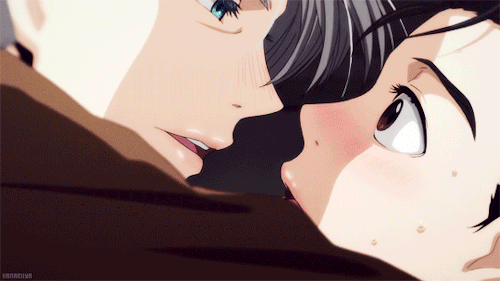
(CONGRATS IT’S A FUCKING KISS, JUST BECAUSE WE DON’T SEE LIP TO LIP CONTACT, DO YOU HONESTLY THINK IT’S ANYTHING ELSE??? gif credit: x)
Once you stop thinking of things literally and wondering why you didn’t get a steamy make-out scene post GPF final, you will honestly be free. Because for all intents and purposes, that pair skate was either a marriage or a sex scene, depending on how you’d like to interpret it. Point is: it shows them consummating their love. Are you following? If their skating represents their love and finally they’re both skating together... Harold, are you listening? Harold... HAROLD.
Another show I love to compare this to is Hannibal. And I know a lot of people have various issues with Hannibal and the moral implications of it and I’m right there with you bud but if you take a step back and look at it as a heavily queer coded piece of media, a very distinct comparison can be made to the end of Hannibal and the end of Yuri on Ice (I know... I know... but STAY WITH ME HERE OK??). Hannibal was made by Bryan Fuller, an out gay man, and although it’s total possible for gay people to write straight characters (obviously!!!!!!!!!!!! kill that gross stereotype!!!!!!!!!!) it makes the queer coding a little more... apparent. (Warning: Spoilers and also... mentions of gore and violence ahoy)
What skating is to Viktor and Yuuri’s love is what murder is to Hannibal and Will’s love (as fucked up as that is). And how do they end the show? With Will and Hannibal (in the most homoerotic way possible) murdering a dude together, viscerally, and then holding each other, covered in blood. Do you see what I’m saying? IT WAS A SEX SCENE. IT WAS A MARRIAGE. JUST BECAUSE THERE WASN’T THRUSTING OR MAKING OUT DOESN’T MEAN IT WASN’T THERE. It’s what’s beautiful about queer coding. We all watch it and go “Oh!!!!!!!!!!!!!!!” whereas all the homophobes watch it and it goes right over their stupid heads and into the void. But yeah, like how the pair skate was Yuuri and Viktor consummating their love, Will and Hannibal fuckin destroying a dude together and then falling off a cliff was them consummating their love.
In conclusion? YOI didn’t queer bait you. The contrary. It gave you a beautiful gay relationship with a happy ending and a promise for more. Let me reiterate that: it gave you a beautiful, 100% canon gay relationship with a happy ending and a promise for more. You just have to squint a little. Read between the lines. Take your Straight Goggles™ that traditional media have glued to your lil noggin right off and realize that you’re not imagining it and they’re not doing it to fool you. They want you to see it. They want you to know that Viktor and Yuuri are in love. They just have to do it in a way where they can maybe get green lit for another season because the world is still a shit place and homophobes still exist, kapish?
Look. This isn’t some theory. I’m not saying this like I think it might be the case. No. I know this. I would bet my entire life on it. Trust me. I will not lead you astray. Viktor and Yuuri are in love. You know this. I know this. Kubo knows this.
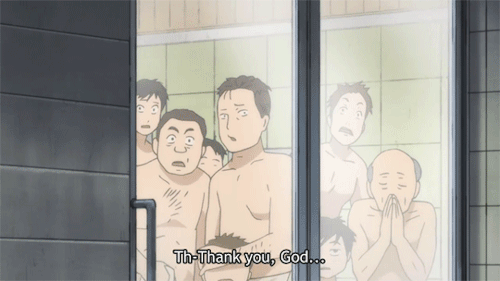
(gif credit x)
#yuri on ice#yoi#yoi meta#yuri on ice meta#victuuri#viktuuri#i hope this made any sense#lmao#queer coding#queer media#queer baiting#queer discourse
101 notes
·
View notes
Text
The Rise Of TikTok | Explained By The News Cover
The News Cover: 2020 has been a year of chaos, uncertainty and grief. A global pandemic, record unemployment and nationwide protests have left people reeling. Through it all though, there's been TikTok, providing moments of levity and new dance crazes, interspersed with more serious commentary on the issues that we face. TikTok, it's like the party you want to be at, a t the moment.
You'll see hair tutorials, cooking tutorials. People can create challenges, they can create duets, th ey can interact, they can engage. T ikTok is the most downloaded app of 2020. Since its global release less than two years ago, TikTok and its Chinese counterpart, Douyin, have amassed 800 million monthly active users, more than Reddit, Snapchat or Twitter. Its parent company, ByteDance, is the most valuable startup in the world. Its reach might surprise you unless you're a member of Gen Z or the parent of one. But as millions scramble for connection amidst quarantines, more and more users of all ages are hopping aboard.
We're all just kind of going through the same thing together. And we happen to be documenting it all through TikTok. It's not all rosy, though. The Chinese-owned app faces a slew of regulatory hurdles, privacy concerns and allegations of censorship. Amidst these struggles, it's brought in a new CEO. This guy is Kevin Mayer. Formerly the Head of Streaming at Disney. That's basically what Kevin Mayer's first priority needs to be, is to make sure that Americans trust TikTok. In the long run, t hat may prove complicated. But in the short term, it hasn't prevented tens of thousands of new users from signing up.
The predecessor to TikTok was an app called Musical.ly. Founded in 2014, it provided a platform for users to create short, 15 second videos set to a song of their choice. The content mostly involved lip-syncing and dancing, and it took off quickly among preteens and teens in the U.S. This is an app that was built around the fact that there was music that was licensed to be used on this app. This was something that Musical.ly decided really to invest in, because they knew that music and sharing music was inherently social.
By July 2015, a year after its launch, Musical.ly reached number one in the iTunes app store. It continued to grow and was bought by the Beijing-based startup ByteDance for one billion dollars in 2017. ByteDance already owned Tik Tok, a similar video sharing platform, and merged the two apps less than a year later. Now TikTok's main office is in Los Angeles, California. They're essentially an American startup that is subsidized by a successful Chinese tech company. As the app has grown, it's given rise to a whole new pack of social media celebrities.
Content is public by default on TikTok, and the algorithm that determines what appears on a user's home page gives every creator the chance to put their video in front of millions. Really what we saw was a different style of humor. It wasn't the sketches that you saw on Vine, and it wasn't longer-form YouTube videos. It was meme culture or like the general public's take on a meme. What I enjoyed about it is there was some deeper humor in there if you were paying attention to the trends that were happening.
On TikTok, King uses creative video editing to make it look like he's performing magic tricks, a skill which has earned him over 44 million followers, the second most on the app as of June 2020. But at 30, King represents the rare millennial that's broken into TikTok's top ranks. Many of the most followed users are in their teens, and lip syncing and dancing remain wildly popular. So I originally started when I was 14 years old, and so I started using my facial expressions and hand motions to make these like larger than life lip sync videos. And as I grew up, I think the app also grew up. Now there's so much more that you can do.
While Martin has found her niche with dancing and lifestyle content, she says there's something out there for everyone. There's like creators who are huge when it comes to comedy, some still do lip syncing, some cooking videos, tutorials. You can do whatever you want as long as it's fun, it's quick and it catches people's eye. Stay at home orders have propelled the app's rapid growth in the United States. So between October and March, according to research fro m Comscore, its unique visitors has grown from 27 million to 52 million, so doubled in the past five months.
And within that time period, just in March alone, according to Comscore TikTok added 12 million new unique visitors. People in the U.S. on TikTok spent more time on TikTok than Instagram users spent on Instagram or Snapchat users spent on Snapchat in the month of March. That's a big deal since Snap and Instagram are two of the app's main competitors. They're all extremely popular among young users, b ut in the U.S. at least, TikTok still has some catching up to do. We estimate that this year TikTok will have 45 million users.
But Instagram, we're estimating will have over 110 million and Snapchat will have 85 million users. But TikTok is also huge abroad, especially in India and China. In China, it operates as a technically separate but very similar app called Douyin. And in the first quarter of 2020, TikTok and Douyin were downloaded 315 million times globally, a 68 percent increase over the previous year. In April, the company reached two billion overall downloads.
India is by far the app's largest market when it comes to downloads, accounting for 30.3 percent of the total. But China is definitely the largest from a revenue standpoint, accounting for about 72 percent of total spending on the app. The U.S. is third in terms of downloads and second in terms of revenue, and its influence continues to grow. Viral dances and memes have propelled a number of songs to the top of the U.S. charts, most famously, Old Town Road in 2019 . And now the moms, dads and siblings of the TikTok o bsessed have started to get in on the trends as well, learning dances and performing challenges together.
You're still laughing at them, but actually the fact that parents are getting on it, I mean they needed that demo so badly to even make it to this level that they're at now. In order to build out a sustainable revenue model, e xperts say that TikTok eventually needs to attract older users. Advertisers are going after broader demographics and especially those with purchasing power. But TikTok is not under immediate pressure to make money just yet. Its parent company ByteDance is valued at over 100 billion dollars and made three billion dollars in revenue last year.
That's because it owns a host of other, more profitable Chinese apps, most notably Douyin and a news aggregator called Toutiao. TikTok's revenue model is still very, very nascent. This is a company that has some advertising, we have some of the users starting to do sponsorships. But at the end of the day, this is a company with hundreds of millions of users here in the U.S. that's still not making as much money as it could some day. Monetization aside, many say that CEO Kevin Mayer's first priority needs to be the regulatory and privacy concerns facing the app, which stem from its Chinese ownership as well as its popularity among children.
You know, it's never been the case that so many Americans are putting so much of their visual data in the hands of a Chinese company. And as we know, the relationship between the Chinese government and Chinese corporations is a pretty tight one. While TikTok claims that all American user's data is stored within the U.S. and is not subject to Chinese law, many security experts remain skeptical. Similar concerns exists in India, where data protection laws are weaker and thus citizens are more vulnerable. Regulators are going to be very weary of that separation.
Where's the data held? What's the cross-pollination look like? A number of incidents over the years have provided ample reason for worry. An investigation by The Guardian last September revealed that TikTok moderators were instructed to censor videos related to Tiananmen Square and other content deemed sensitive by the Chinese government.
While the company claimed that these guidelines had been phased out by the time of the investigation, it still helped spur the Federal Committee on Foreign Investment in the United States to open an ongoing review into ByteDance's acquisition of Musical.ly. It seems unlikely that ByteDance would be forced to divest itself of what was Musical.ly, now is TikTok. But I do think that this all speaks to the great amount of concern and oversight over this app that's gone from a tiny little thing to this huge powerhouse.
Most recently, the app received criticism for what it said was a technical glitch, in which post tagged with #BlackLivesMatter and #GeorgeFloyd appeared to have zero views when they actually have over two billion. And in the past, both India and Indonesia have instituted brief bans on the app due to concerns over inappropriate content like violence and pornography.
Lastly, there are ongoing issues regarding children's privacy. Users under 13 are technically not allowed on TikTok, but there's not much really preventing them from signing up. In February 2019, the company paid 5.7 million dollars to the FTC to settle charges that it was illegally collecting children's personal information. This then prompted the U.K. to conduct their own investigation into the matter. While TikTok said it would make changes, in May 2020 a coalition of consumer groups filed a complaint stating that TikTok had not kept its promises.
It's all undoubtedly a lot for Mayer to inherit. But given his background at Disney, some say he may be exactly the right person to address these concerns. So he is someone who has experience dealing with regulation, dealing with oversight, and especially dealing with online security issues, which are certainly front of mind for TikTok as they navigate their relationship with the FTC. If Mayer can secure the trust of U.S. consumers and investors, Byt eDance could be well positioned for an IPO in the next year or two. Beyond that, experts say that TikTok's long-term prospects depend upon its ability to keep users engaged while building out a sustainable monetization strategy.
YouTube could be seen as a model in the way that YouTube shares advertising revenue with its content creators. Mayer's background in streaming services also has both analysts and creators excited about what new forms of content may lie on the horizon. I have been begging TikTok to get into the streaming game. People have speculated that TikTok might get involved in original programming.
To make TikTok sustainable, you're going to have to do long-form content. I don't see a version where you make 60 second videos forever and it stays cool for another two to three years. King also says TikTok's live-streaming feature has room to grow. It's super popular in China, but hasn't yet taken off in the U.S. I think what's next for TikTok is how they figure out how to make money, how they figure out how to create a home for advertisers, and how they make sure that content creators themselves want to stick around and don't want to go jump off to whatever the next cool app is going to be.
from Blogger https://ift.tt/3hwmC8r via IFTTT
0 notes
Text
Those digital cameras relegated to your junk drawer? They're cool again.

Everything from culottes to chokers to old sitcoms have made a comeback at some point or another in our cyclical culture, and now, a piece of technology from our recent past is experiencing a tiny resurgence.
Digital cameras from the aughts are having a moment again, and there's a growing community online making space for them to shine.
The resurgence of relics from the past is usually chalked up to simple nostalgia, but it's more than that when it comes to these cameras — especially to those who have found themselves picking up "digicams" (as they're sometimes called) for the first time in years.
SEE ALSO: 10 of the best instant cameras based on internet reviews
To some, these pre-smartphone cameras are clunky and outdated, and seen as just another cheap find in thrift stores or junk drawers across the country. But in 2018, early digital cameras have made their way into the hands of professional photographers. Now a few of those photographers are cultivating a community of digicam users and providing a platform to showcase work crafted using pre-iPhone portrait mode technology.
If there's one place online for digicam users to show off their work in a community setting, it's @digicam.love. The Instagram account posts photos from folks who've snagged a Canon Powershot A3500 from 2013 or a Panasonic Lumix DMC-FX150 from 2008 and are ready to show the world that these little cameras can hold their own, even by 2018 standards.
Since its creation in January, the account's grown quickly over just seven months. As of publish date, it has 850 followers and three moderators who go through submissions to share work done by other photographers who shoot with digicams. Two of those moderators, Sofia Lee and Bao Ngo, founded the account after embarking on their own personal digicam journeys.
Lee, a photographer and GIF maestro based in Seattle, Washington is one of the fiercest advocates for the return of the digicam. With a collection spanning cameras from throughout the 2000s that she's amassed over the years — her first was a Canon PowerShot G2 — Lee is bonafide digicam lover, and her interest in these "vintage digital cameras" (a term dubbed by Digital Photography Review) all started with a dream.
"I know this sounds really trite, but I basically had a dream one summer a few years ago where I saw a digicam JPEG of a mountain," Lee told me via email. "When I woke up, I had this feeling that there was something about the older cameras that I'd been missing — that they produced images that were truly unique."
A post shared by sofi💫 (@lofisofi) on Dec 7, 2017 at 7:42am PST
She's right — they do produce distinctive images. In addition to being physically different from the popular DSLR camera of today, they also offer a different shooting experience than a DSLR or a smartphone camera would.
"They tend to create images with deep sharp focus, because of the optics and sensor size, so I must be cognizant of everything in the frame; I can’t rely on bokeh to blur things out," Lee explained, referring to the photo effect that a shallow depth of field can produce in the background of images. "They teach me to be patient and careful with my photography. They teach me to get everything right in the moment because there is very little leeway to save the images in post if I expose wrong."
Though there's often debate between photographers who shoot exclusively using DSLR cameras versus those who use film exclusively, digicams rarely come up in these conversations, despite the beautiful results they produce.
To Lee, digicams are "wedged between this 'analog vs digital' debate going on in photography right now." They're often left behind in debates over the merits of what cameras to shoot with professionally, and according to Lee, "there is a social and philosophical aspect to this discussion that often gets ignored." They have the potential to start a conversation about who gets to participate in the art of photography.
Ngo, whose work can be seen in magazines and on album covers, considers digicams a valuable tool not only because of the images they produce, but because of how affordable they are.
A post shared by digicam love (@digicam.love) on Mar 8, 2018 at 9:12am PST
Ngo started taking pictures at a young age with a digicam, but built her career shooting primarily with film cameras. It quickly became a pricey endeavor thanks to the increasing cost of developing film. She eventually made the switch from film to digital because of rising costs, and in 2017, she started using a small point-and-shoot — a Sony Cybershot DSC-T10 — and hasn't put it down since.
"When I switched from digital to film, I thought I had to have an expensive digital camera," Ngo told me. "I thought it had to be really great, and I don't regret [buying the DSLR] ... it's good for what it is, but I thought that it was kind of ridiculous that I have to spend this much money in order to not pay for film anymore."
"Growing up in a family that didn't have a lot of money, I think that financial accessibility in art is really important," she said. "I just didn't have money for equipment growing up and to this day I use fairly cheap equipment. I just kept thinking that there has to be a way for photography to be more accessible because something I hear from people a lot is, 'Oh I want to get into photography but I can't afford a camera or gear.'"

Shot with a Sony DSC-T10 camera
Image: bao ngo
After years of online friendship between Ngo and Lee, the two met for the first time just a few years ago, and Lee's use of digicams came up in their conversations. This eventually prompted Ngo to pick one up for herself.
"Something went off in my head after shooting only a couple photos on it," Ngo said. "I realized the images it produced are actually really beautiful."
After purchasing her digicam (she went with a Sony Cybershot DSC-T10), Ngo compared photos taken on her iPhone to ones snapped with the digicam, and was taken with the colors produced in the latter.
"I heavily edit the photos that come out of my iPhone and [DSLR] but digicams look really beautiful," she explained. "Some people like film because they perceive it to be imperfect — and I appreciate digicams because I feel that way about digicams."
And while the capabilities of older digicams might not match the latest technology available in DSLR models from manufacturers like Canon or Nikon, it's worth noting that digicams do have their strengths. For example, Ngo's digicam retains highlights surprisingly well. In the images below, note of the green light emanating from the building in the lower lefthand side of the images. In the digicam version, it's still green, but in the iPhone version it's a blown out, muted yellow.

Taken with a digicam ...
Image: Bao Ngo

... and taken with an iPhone
Image: bao ngo
Lee and Ngo have both shot professionally with digicams, but if you ask most career photographers about their gear for personal or professional use, a digicam might not come up in discussion.
Dee Williams, a photographer who primarily shoots portraits of women of color, is one of the few who have gone back in time with their camera choices. Though she usually shoots professionally with a DSLR and film cameras — which she loves despite the piling costs that come with development — this hasn't stopped her from trying out the digicam.
In April, she picked up a Sony Cyber-shot DSC-WX350 digicam at the suggestion of another artist, and is slowly incorporating it into her life as a photographer. Her interest in a point-and-shoot was purely practical.
"I was just really tired of carrying around my heavy cameras," she said. "I do feel like photographers should have a camera with them 24/7 so I thought, hey, let me get something small, cheap, and affordable that I can put on my waist or strap on my backpack so I can always be ready to take photos."
With it came some pleasant surprises, she said.
"I don't know how to explain it but there's like the vintage, old school look with the digicam," she told me. "You're not getting crazy depth of field, and the colors are not as sharp or crisp as a DSLR but you're still getting that cool, timeless, digital shot. It takes amazing photos. I can definitely see myself using it in a professional setting at music festivals."
Still, she isn't convinced she'll turn it into her number one pick on photoshoots. For an additional camera on deck though, she explained, it's a go.
A post shared by digicam love (@digicam.love) on Apr 12, 2018 at 3:53pm PDT
Lee and Ngo's @digicam.love platform is made for photographers like Williams who are beginning to use digicams in their everyday lives. "I definitely was interested in seeing if there were other people like us out there who had become enamored with digicams," Lee explained. "It’s thrilling to see people become more interested in this."
Since it's inception, Lee and Ngo have added a moderator, Froyo Tam, into the fold to help run the account. And whether it continues to grow or remains a niche corner of the internet, it's spilling into offline communities as well. The @digicam.love team has gathered folks for photowalks in various cities around the world (the next one is in Seattle at Washington Park Arboretum on August 11).
It'll be their fourth photowalk, but it already points to one thing: the digicam is making a small and mighty comeback.
UPDATE: Aug. 1, 2018, 11:06 a.m. EDT The story has been updated to reflect that Froyo Tam runs @digicam.love alongside Lee and Ngo.
WATCH: These VR gloves allow people who are blind to "see" art for the first time

#_author:Martha Tesema#_category:yct:001000002#_lmsid:a0Vd000000DTrEpEAL#_uuid:672a72c8-cfe3-3817-bcec-97b37d070686#_revsp:news.mashable
1 note
·
View note
Text
assignment 1
In Kurt Anderson’s criticism of cultural stagnation, he states that the aesthetic aspect of American society has remained at a plateau since the 1970′s. However, such a controversial statement is not without its faults, especially considering that the article was written 6 years ago. Andersen compares the bold fashion and lifestyle of young adults in the 70’s as opposed to the 80’s and onwards, stating that the visual differences were so distinct in contrast that a time traveller would have no trouble blending in.
Yet there were many factors that Andersen overlooked in his criticism. The 70s in particular were a special case. The reason for such a drastic change in style was heavily influenced by the specific sociopolitical situations of that time; the introduction of newly created mind-altering drugs, JFK’s assassination, the Vietnam War, and the then-recent Civil Rights Movement all helped to shape the collective thought of young adults, directly impacting lifestyle and fashion as well. as seemingly revolutionary a style as the 70’s were, the hippies drew their inspiration from pre-established institutions of thought such as Buddhism, with messages of peace, and Der Wandervogel, a German youth movement originating from 1895 that emphasized personal freedom and reconnecting with nature.
Andersen points out how literary classics written 20 years ago can still be applied to the context of today, which would be a fair point to make had he not attempted to make it seem detrimental to cultural innovation and progress. The law of conservation of mass states that matter cannot be created or destroyed; it can, however, be rearranged. A similar concept can be applied to ideas. No person can create something out of nothing. Shakespeare’s works have remained a scholastic staple despite their age. This hasn’t stopped other writers from creating new works that may reinterpret bits and pieces in a different way.
So why does he believe that the difference between the 2000s and the ‘90s is so difficult to spot in comparison? For one thing, from the 80’s onward, the advancement of technology has resulted in significantly less US war casualties in comparison, which has also shaped collective social, political, and even environmental thought by proxy.
Andersen accuses Americans of “scrupulously attending, as never before, to the details and meanings of the design and décor of their homes, their clothes, their appliances, their meals, their hobbies, and more,” disregarding the possibility that due to this time of relative peace, we have progressed to a point where the bases of the human needs pyramid of our society are largely stable (food, housing, health, etc) enough for us to focus on other things such as personal appearance and style. He also claims that “the things [Americans] own are more than ever like props, the clothes [they] wear like costumes, the places where [they] live, dine, shop, and vacation like stage sets” to build up to his point that Americans long for “authenticity” in an age of rapid technological growth. This subtle implication that scientific advancement is somehow ‘superficial’ contradicts his own criticism towards the supposed stagnation of societal development as a whole. He fails to address the fact that our society thrives on consumer culture, meaning that elements of fiction are often based off of real life ( and vice versa) to appeal to that sense of familiarity for marketing purposes.
Furthermore, Andersen’s most crucial mistake was his self-contradiction in attempting to separate the growth of pop culture from the growth of technology. He first claims that “the only thing that has changed fundamentally and dramatically about stylish objects (computerized gadgets aside) during the last 20 years is the same thing that’s changed fundamentally and dramatically about movies and books and music—how they’re produced and distributed, not how they look and feel and sound, not what they are,” before backtracking and claiming that “anyone anywhere with any arcane cultural taste can now indulge it easily and fully online, clicking themselves deep into whatever curious little niche (punk bossa nova, Nigerian noir cinema, pre-war Hummel figurines) they wish.”
Technological growth has woven itself into so many other aspects of our lives that to simply do away with it in an analysis of American pop culture would be impossible. Social media has combined both political and social trends in one platform, examples ranging from the Arab Spring and the Black Lives Matter movement to Youtube celebrities, many of whom have become defining characters of entertainment today.
As for the visual appearance of youth today, it’s rather inaccurate to say that style has simply been recycled over the past 20 years. There are many factors of recent events that have influenced modern fashion. Starting with 2012 up to the present, there have been many significant changes, from the legalization of same-sex marriage and advances in transgender equality, to increasing visibility and representation for POC, to the rapid growth of the entertainment industry---the effects have been visible. Fashion has branched off into countless styles (goth, hipster, lolita) and become wildly more colorful, more experimental, now that people are starting to break free from the traditional constraints of gender & style, away from the traditional sense of what looks “good” or “bad.”
With the improvement of social equality, creators that never would’ve had the opportunities they did 20 years ago are now able to see the efforts of their talent come into fruition as they directly influence the visual, musical, and literary fabric of our culture for the generations to come.
0 notes
Link
On Tuesday, May 30, WGN America canceled its Underground Railroad drama Underground, which had earned critical plaudits and generally solid ratings for the network. A few months earlier, it had canceled its rural America-set Outsiders, which also boasted generally good viewership numbers. Each show had run for two seasons.
WGN’s explanation for both cancellations? The network is shifting focus — away from scripted TV. (Whether that means its focus will shift to reality programming or just reruns of shows from other networks remains to be seen.)
That shift in focus is perfectly justifiable, as far as WGN’s business strategy is concerned.
But in the context of several recent developments that otherwise seem unrelated — A&E similarly abandoning the scripted market after Bates Motel wrapped up earlier this year; MTV’s cancellation of its promising (but low-rated) freshman drama Sweet/Vicious; Netflix canceling The Get Down after its first season (the streaming service’s first post-season one cancellation ever) and Sense8 after its second — a natural question has started to rocket around the TV industry: Is Peak TV, the era of so much TV you can’t even keep up with it, over? Are we about to start racing down the other side of the mountain, with little control over the speed of descent?
The answer to that question, as with most questions about the entertainment industry at this moment in time, is “yes and no.”
It’s easy to argue that Peak TV is still going strong
First, let’s look at the case for “Peak TV is here to stay for at least a little while longer.”
The concept of “Peak TV” is quite young, even if doesn’t feel that way. The exact definition of the term dates to 2015, when FX Networks president John Landgraf gave a now-famous presentation at that year’s Television Critics Association summer press tour; Landgraf was defining a business phenomenon — a bunch of new players were jumping into the scripted TV market and consequently driving up the number of shows being made.
But what he said spoke more broadly to an overall trend that TV journalists and viewers felt in their bones. There was too much TV. “Peak TV” suddenly became the most popular way to refer to the 2010s — TV’s latest so-called “Golden Age” had given way to an inundation of choice.
John Landgraf introduces the phrase “Peak TV” to the world. Photo by Frederick M. Brown/Getty Images
Strictly speaking, Peak TV can’t be over yet, by Landgraf’s own definition. There will be more scripted series in 2017 than there were in 2016, and the odds are very good that there will be more scripted series in 2018 than in 2017. The number of scripted shows crested 500 for the first time in 2016, and it has a reasonable shot at brushing against 600 before the peak is truly reached. (Meanwhile, unscripted shows numbered over 750 in 2015 and continue to climb.)
And if we start scrutinizing the various bricks in the “Peak TV is ending” argument, each can be explained fairly easily. WGN and A&E ventured into an expensive market and found it too rich for their tastes. The Get Down and Sense8 might have aired on loath-to-cancel-things Netflix, but they still cost the streaming service tons of money to produce, and TV shows rarely get less expensive as they go. The same argument — that production costs outweighed the show’s value to Netflix — also largely explained the network’s decision to cancel Bloodline, and basically nobody argued that “Peak TV is over!” after that choice.
The simple fact of the matter is that the networks that are genuinely getting out of scripted TV were super-marginal players, at best.
As one network head pointed out to me, if you look at the 15 or 20 cable networks that produce the lowest number of shows — usually one or two per calendar year — their combined scripted output is close to that of Netflix alone. The streaming boom is driving the current glut, and with Hulu ramping up its own production arm alongside Netflix and Amazon, it seems unlikely to suddenly stop.
That conclusion is only bolstered by persistent rumors that YouTube will push even more into the scripted space (as it’s already flirting with doing), or that Facebook will launch a bunch of series, or that Apple and Google will do so as well. (Apple and Facebook are already dabbling in the unscripted space.) To be clear, it seems unlikely all of these potential players will enter the scripted TV game, but some of them will, and they’ll only inflate numbers further.
The industry figures I talked to while researching this article all agreed that if the TV industry revolved entirely around cable and broadcast television, it would have already reached a peak and be entering a gentle descent, as some networks exited the scripted space while others stepped back their production.
Yet the major players in scripted TV — which include the most acclaimed cable networks like HBO and FX, but also the big four broadcast networks and a bunch of more middlebrow cable networks like USA and TNT — remain committed to keeping their slates mostly stable. When Landgraf predicted, in 2015, that the Peak TV bubble would eventually deflate at least a little, he was probably thinking about something very much like what’s happening in cable and broadcast right now.
But “cable and broadcast” aren’t where the major gains in the overall number of TV series are coming from. Those gains are all a byproduct of streaming networks’ increased demand for original programming, and so long as that demand exists, the true “peak” of Peak TV won’t come. I’d say we’ve got until at least 2018, if not 2019, before it arrives.
And even that might be too early — Landgraf famously predicted the peak would arrive in 2016, and look where that got us.
Still, it’s not hard to look at a bunch of recent cancellations and wonder if they’re indicative of changing tides
The cancellation of Underground might have led to a pickup by another network a few years ago. That’s less likely in 2017. WGN America
Right now, if you talk to people in the TV industry about the current status of Peak TV, you’ll usually hear some variation on this phrase: “I can see where this would look like a bubble, and sometimes it feels like a bubble, but I don’t think it’s a bubble.” And if Landgraf’s initial prediction — that we’d see a steep ascent to a peak, then a gradual decline as the market culls shows that can’t even garner a niche audience — proves accurate, then, yeah, the bubble was more of a market test.
But it’s not hard to look at Netflix ordering dozens of scripted series and wondering when that approach will prove unsustainable. At some point, the network will reach a plateau in global subscribers, especially as it’s proved unable to crack the Chinese market, and then it will have to start tightening its belt. That will inevitably mean the end of some of its more marginal series.
One of the driving factors behind Peak TV was the idea that everybody was getting into the pool. And by extension, the idea that, because viewership can be amortized over lengthy periods of time, it doesn’t really matter if the Twin Peaks premiere only drew 500,000 live viewers. For Showtime, the simple fact that subscriptions to the channel are up because people want to watch the series is the only thing that matters. If you want to watch Twin Peaks and are willing to pay for the privilege to do so, who cares if you want to do so at 9 pm on a Sunday?
This type of thinking has caused lots and lots of networks to test the waters, but few of them have the kind of production arms that will allow them to make money off the shows they’ve been airing, at least not far into the future. Twin Peaks will still be valuable to Showtime for decades because both the show and the network are owned by CBS Television. But that kind of streamlined parentage didn’t exist with Underground, which was itself owned by Sony, while WGN is owned by Tribune Media. Most of the players exiting the scripted TV industry are ones who don’t have natural studio partners in the way that, say, Showtime or FX do.
And yet the gradual decline in the number of networks seeking original scripted programming means that there are simply fewer places to sell scripted programming to, even if Netflix and Hulu are buying up every show they can find.
When discussing Underground’s cancellation with some Vox colleagues, I noted that even a year ago, there would have been a more robust market for another network to pick up the show from WGN and give it a third season (as happened with, say, A&E castoff Longmire, which went to Netflix). In 2017, it’s harder to imagine, because there are fewer networks trying to make a big splash entry into the scripted TV space. (That said, I think Underground still has a solid shot at finding a new home — the bottom hasn’t fallen out of the market yet.)
Peak TV, like everything in the entertainment industry in the digital age, is both built on a sound economic model and a kind of shared delusion. It’s easier than ever to make a lot of money off of even a low-rated TV show because there are so many more places to sell it to and so many more ways to fund any given project. (One increasingly common one: Netflix co-productions where networks retain rights to air a show in the US, but Netflix, its co-producer, airs the program overseas, where its libraries tend to be skimpier.)
But operating within that space, when you’re running a TV network, also requires believing that it will keep getting bigger and bigger and bigger, and that shows will be able to provide for themselves even when they serve only the nichiest of niche audiences. We don’t have hard data for most streaming shows; we only have the tidbits Netflix and Hulu (and some cable networks with streaming platforms, like HBO and Showtime) care to share.
The whole enterprise feels slightly like a magician trying like hell to keep you convinced that he’s performing real magic, even as you spot his hand sliding a supposedly disappearing ball into his back pocket. The instant you realize how the trick works is the instant it all falls apart. Peak TV isn’t over yet, but it increasingly feels like the slightest jostle — venture capitalists losing confidence in Netflix, or a mild recession, or a major unscripted hit taking over the discourse �� could make everybody realize, all at once, that the sleight of hand was always happening right out in the open.
via Vox - All
0 notes
Text
IT MAY BE JUST AS HAPPY SPEAKING ANY LANGUAGE THAT WAS UNAMBIGUOUS
Even if they only end up being more productive. Millions of people are publishing online, and the threat to them isn't mortal. You're flying on instruments, in effect, put you in a position to get lucky: you can now get rich by creating wealth, and others to Hot Pockets. Startups are still very rare. Yech. It's not that people think of grand ideas but decide to pursue smaller ones because they seem safer. General Motors. And not only in intellectual matters.
Few adults aspired to look dangerous in 1950. If it takes longer to find the rest. That brings us to our fourth counterintuitive point: startups are all-consuming. And if you just follow your own inclinations. Here I want to zoom in on one detail of this picture. And once started this process spreads through the whole economy, because at that point the future flips state. It becomes a heuristic for making the right decisions about language design. Startups are very counterintuitive.
It might seem that nothing would be easier than deciding what you like. Your watch? One of the cleanest, most abstract design problems is designing bridges. The founders sometimes think they know. Won't we just tell computers what we want them to do? But elegance is not an irrational fear: it really is hard to bear. If investors can no longer guess what will work; you have to discover, not something you naturally sink into. Some kinds of waste really are disgusting. So if you want to solve a problem their founders had. But I don't think there's an answer. But more people could do it than do it now. Aggregators show how much better you can do than the channel.
In the past, founders rarely kept control of the board through a series A is unheard-of. At this point he is committed to fight to the death. It was really close, too. The sixth largest center for oil, or finance, or publishing? The replies surprised me. Designing algorithms for routing data through a network is a nice, neat but wrong slogan, and churned it up like a mud puddle. In a traditional series A round than an angel round.
And it's not just the lazy ones. We saw this happen so often that we made up a name for this: premature optimization. Most books are bad. If it is, it will take over your life for a lot of money. That may not seem surprising. Since the VCs who don't adapt will be investing later, their returns from winners may be smaller. Plenty of successful startups have had that happen. When I was running Y Combinator I used to write. It's like the hypothetical case of an irresistible force meeting an immovable object—here, an unimaginably inefficient implementation meeting unimaginably great resources. He just cannot fail now.
Strings only exist for efficiency. We're taking on some consulting projects, but we're going to keep working on the startup. Basically, Apple bumped IBM and then Microsoft stole its wallet. To be fair, the universities have their hand forced here. You're worrying about construction delays at your London office instead of the broken air conditioner in your studio apartment. But the next step, whatever that is. Why don't more people do it? Incumbents faced new competitors as a markets went global and b technical innovation started to trump economies of scale, turning size from an asset into a liability. You launch something, the early adopters try it out, and if you can avoid it, b pay people with equity rather than salary, not just to save money. If you can just define a new function to add them. Unless they've tried not taking board seats and found their returns are lower, they're not going to kill the company. Since the hundred-year language will work to varying degrees depending on how close you are to the core.
Imagine how depressing the world would be if it were all like school and big companies, where you need to do: find a question that makes the company prey to a lawsuit. Maybe it's just because knowledge about them hasn't permeated our culture yet. If the company promised to employ you till you retired and give you a pension afterward, you didn't want to extract as much from it this year as you could. As in software, when professionals produce such crap, it's not imaginary either. But change was coming soon. In 1960, corporate CEOs had immense prestige. And I think there will need to be in a hundred years, maybe it won't in a thousand. Mark Zuckerberg didn't succeed because he was an expert on search was to be a high school. The cheery, bland language of the office is replaced by wicked humor. The problem is not so much the money itself as what comes with it. If I were talking to a guy four feet tall whose ambition was to play in the NBA, I'd feel pretty stupid saying, you can just avoid dying, you get rich. Then they want to hack the source.
Most of the groups that apply to Y Combinator suffer from a common problem: choosing a small, obscure niche in the hope that this constraint will prod them into action. If you're super good at sounding like you know what? Which leads to our sixth and last counterintuitive point: that the tests involved are so different from the ones in their previous lives. It was no coincidence that the first yuppies worked in fields where it was easy to tell how smart you are. It may be just as well not to do that at any age? Batch after batch, the YC partners warn founders about mistakes they're about to make, and the Duplo economy was an evolutionary phase. Because another of the characteristic mistakes of young founders is to go through high school again, I'd treat it like a day job. It was a classic metacircular interpreter written on top of Common Lisp, with a definite family resemblance to the eval function defined in McCarthy's original Lisp paper. At first there's a list of articles written by people who needed it for systems programming. Com, the new CEO wanted to switch to Windows—even after PayPal cofounder Max Levchin showed that their software scaled only 1% as well on Windows as Unix.
#automatically generated text#Markov chains#Paul Graham#Python#Patrick Mooney#force#founders#past#constraint#money#cofounder#board#apartment#IBM#core#Com#online#interpreter#VCs#Max#fear#optimization#implementation#conditioner#Levchin#fields#language#problem
0 notes